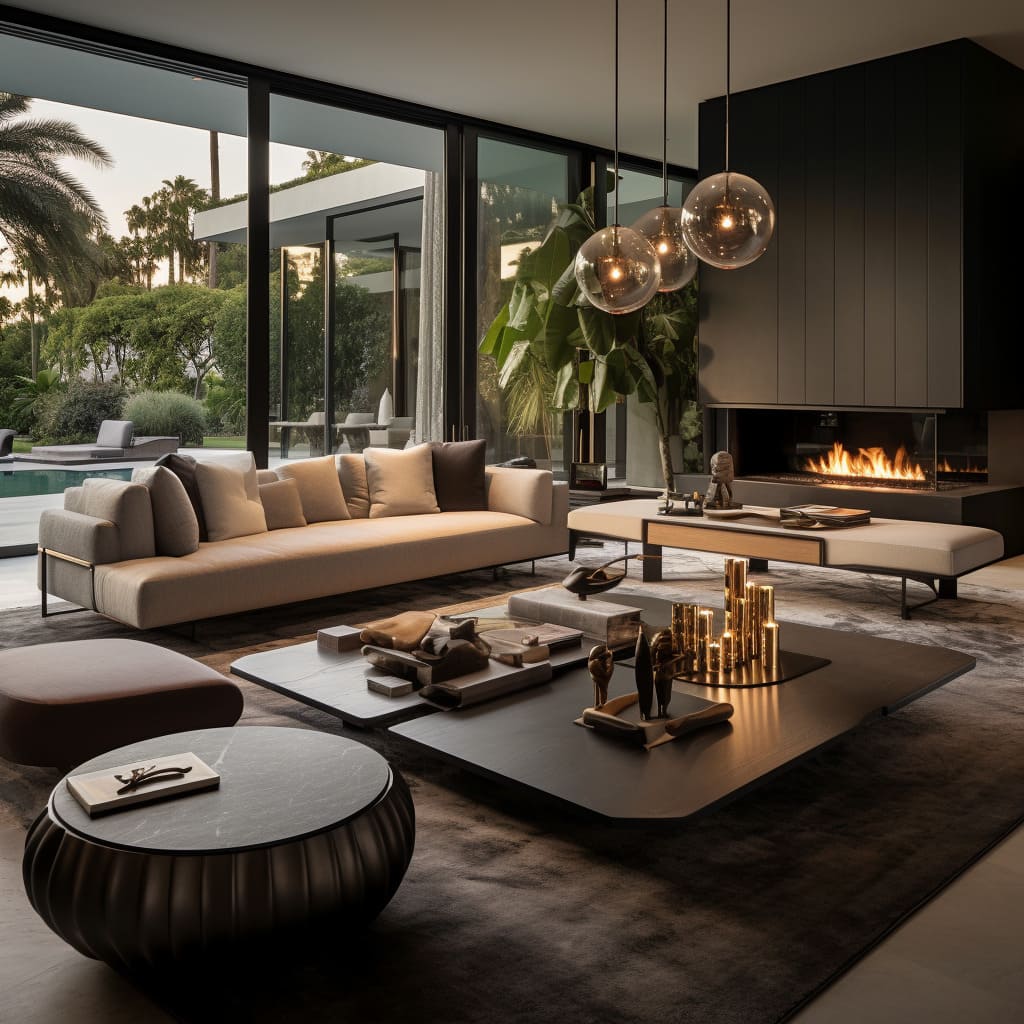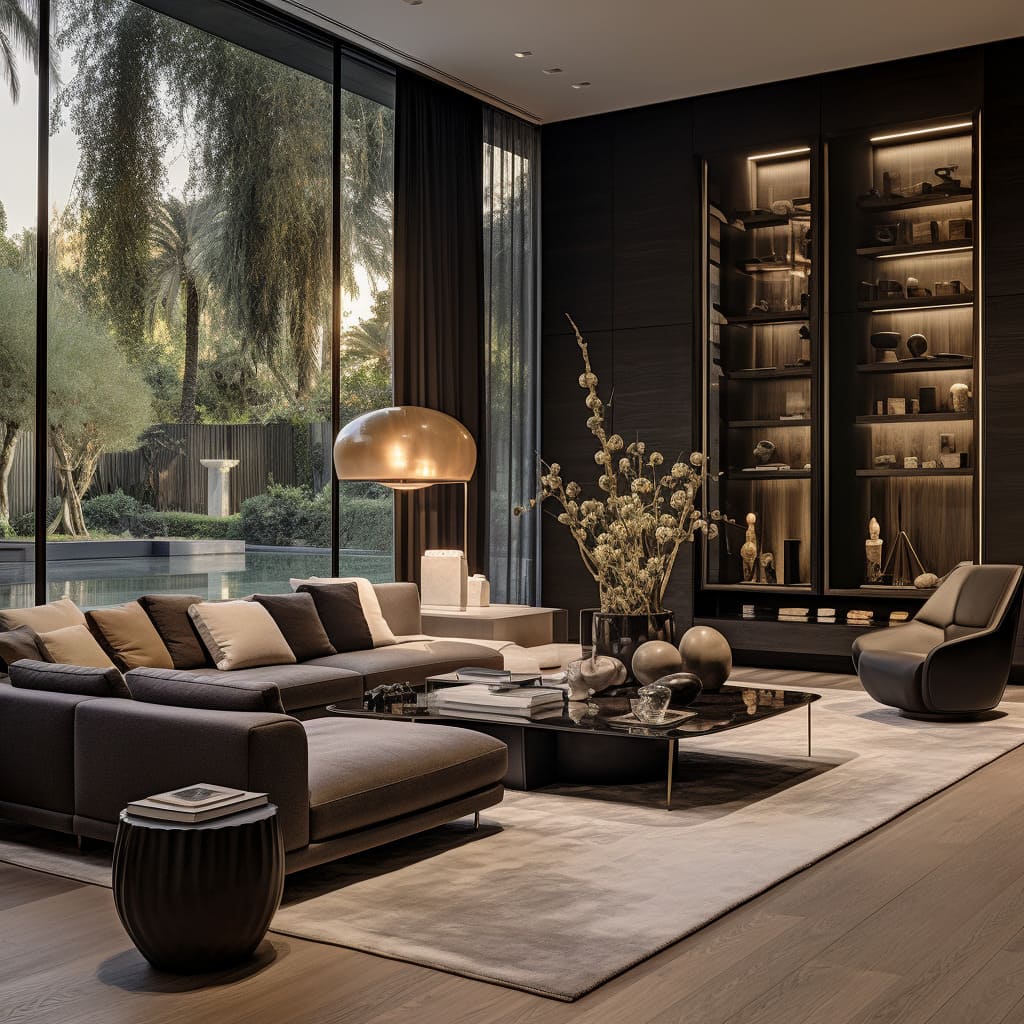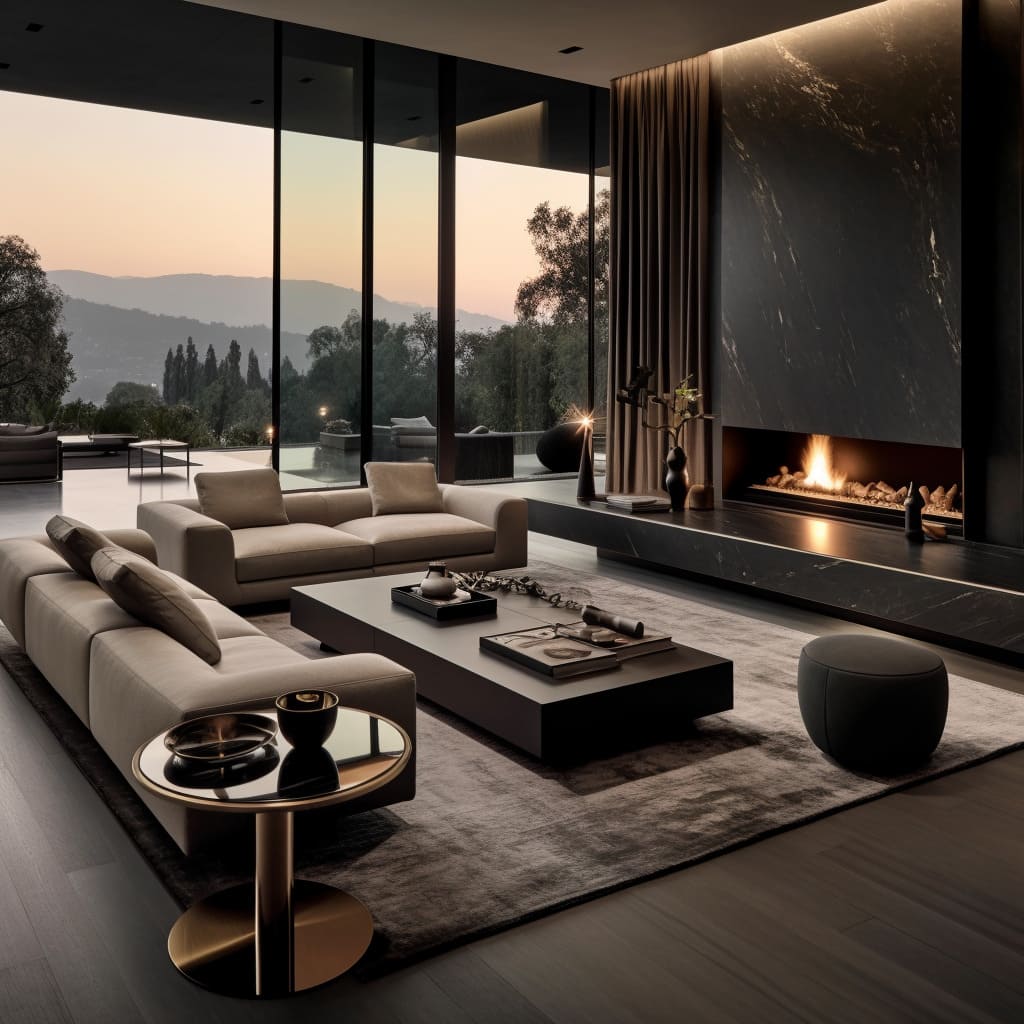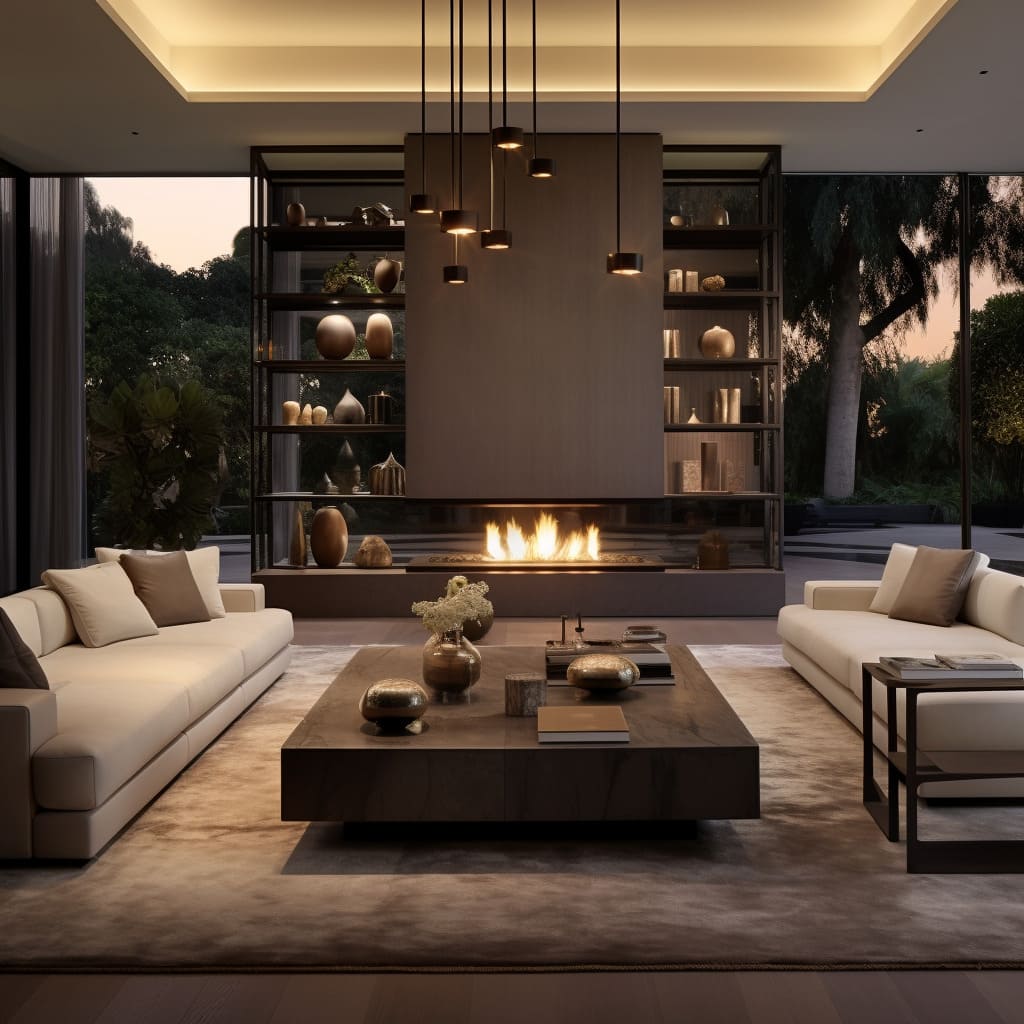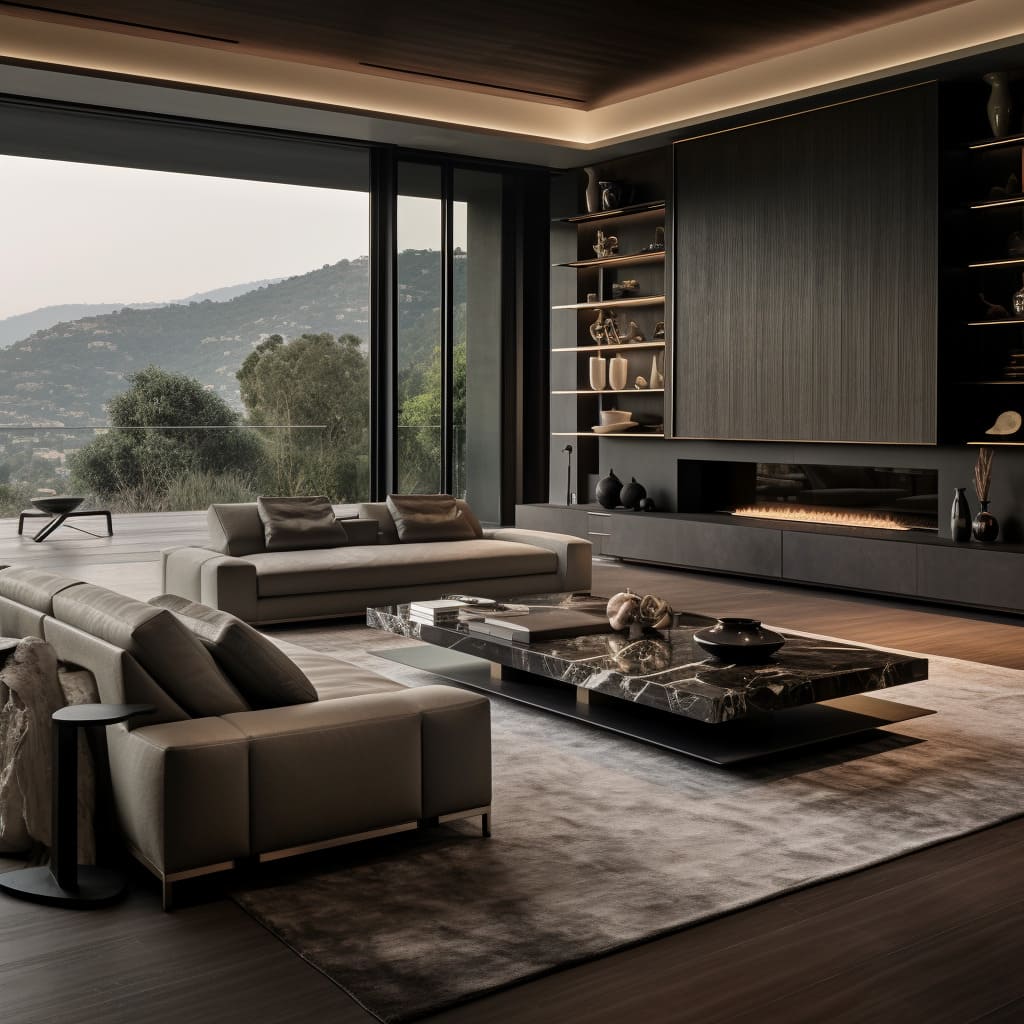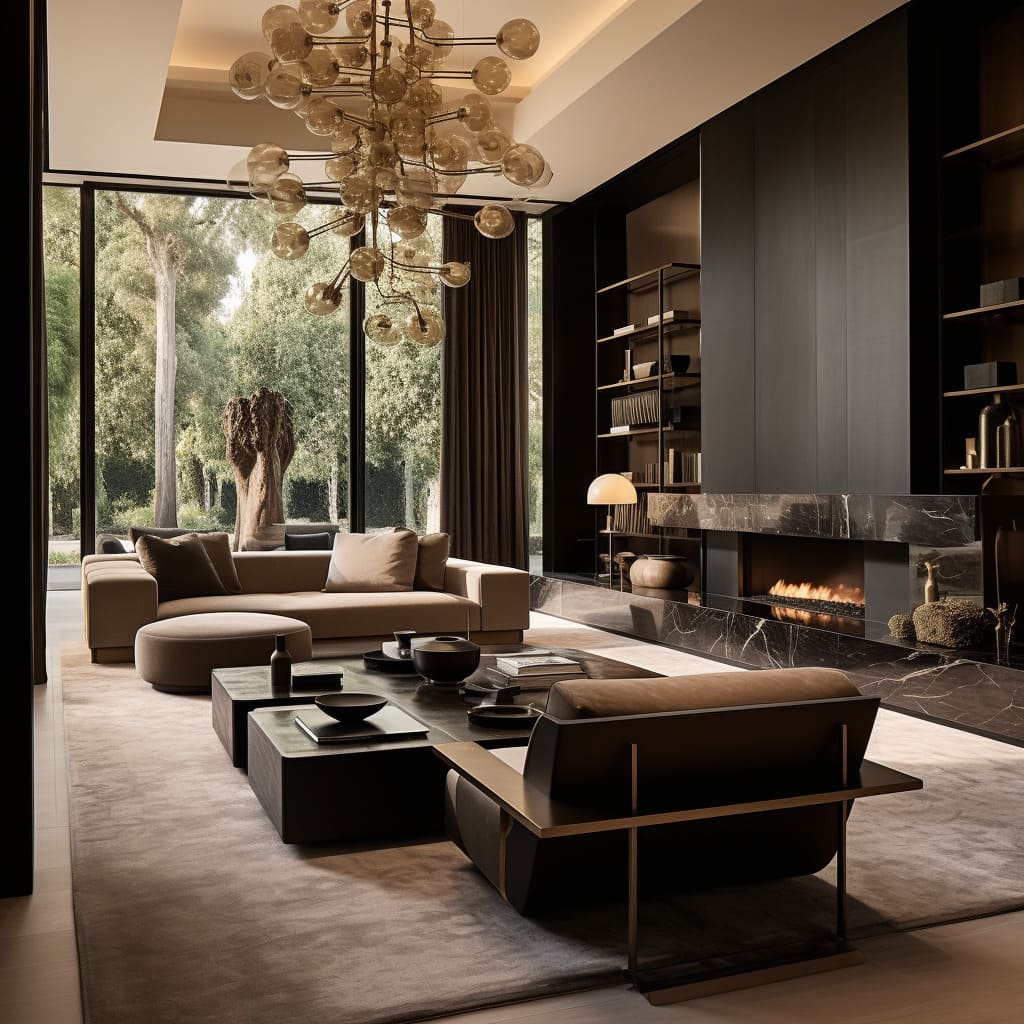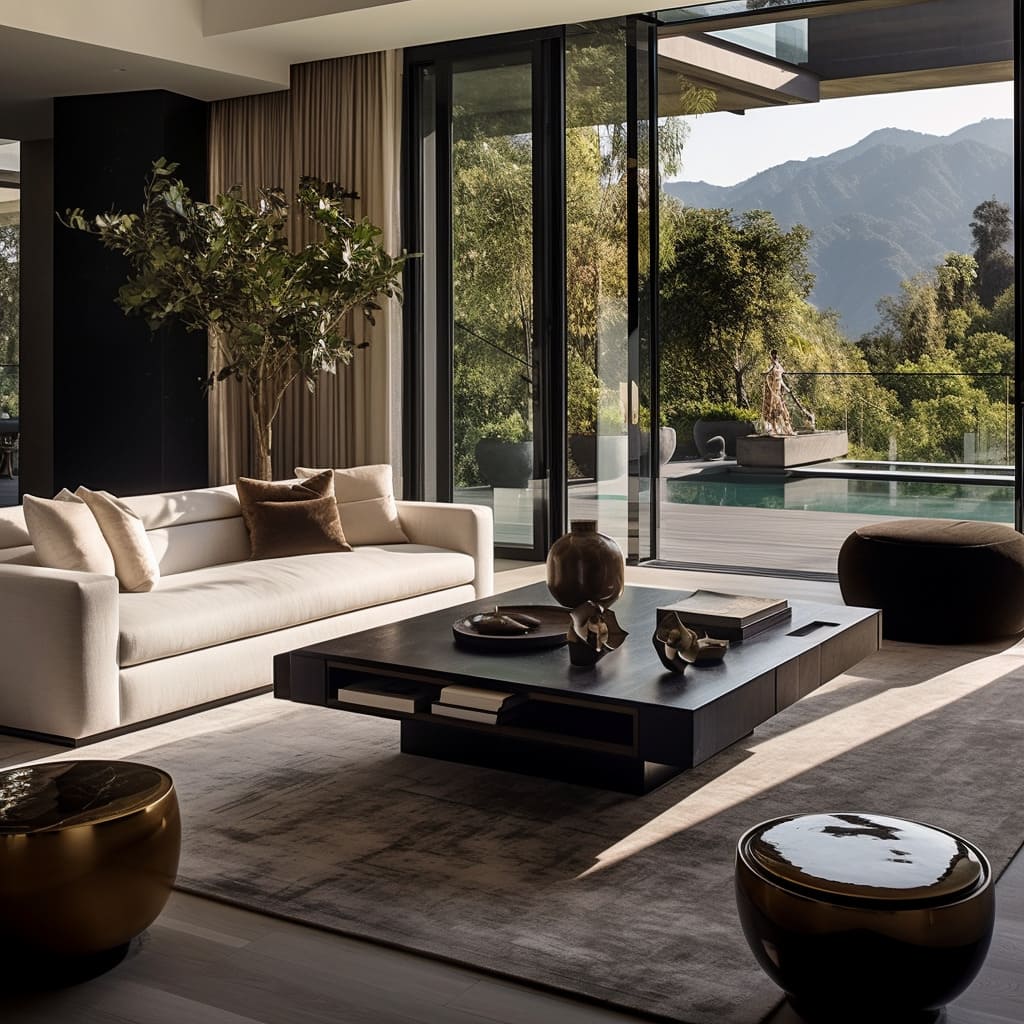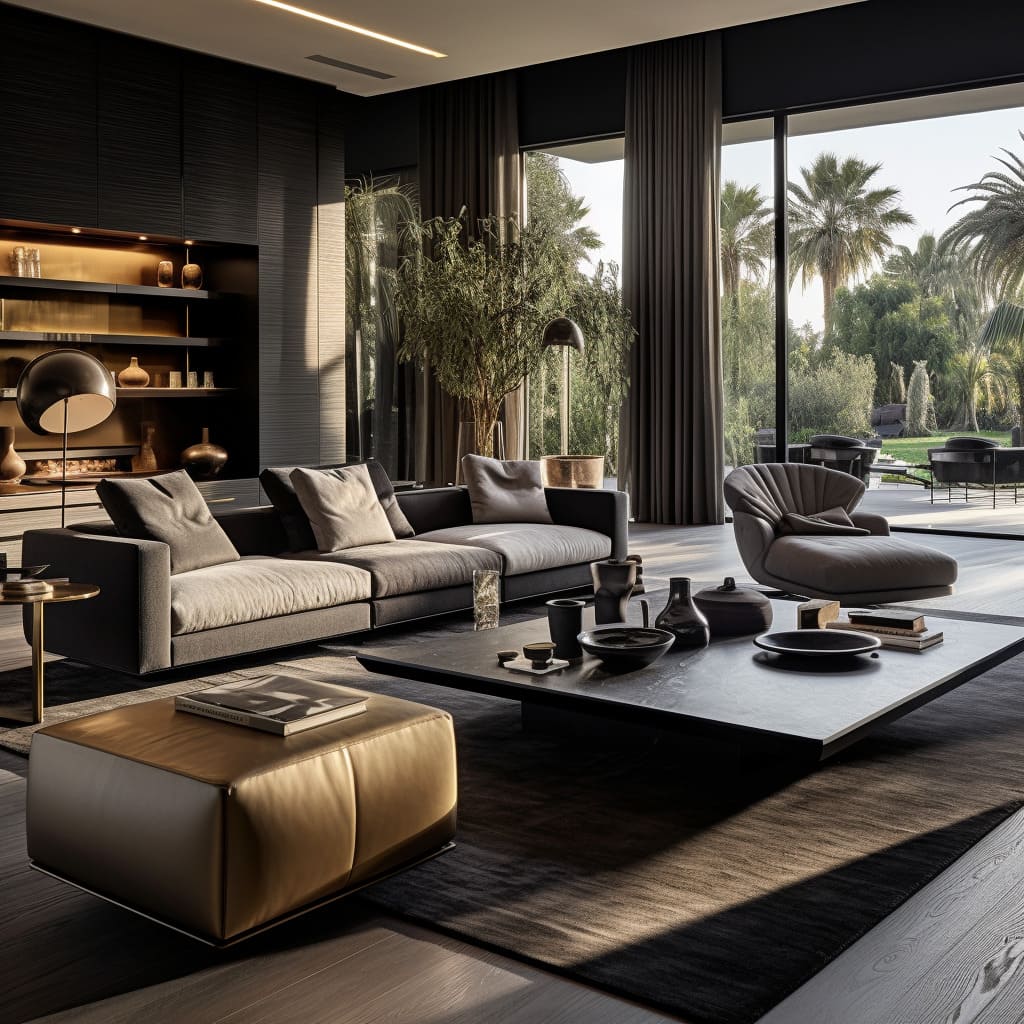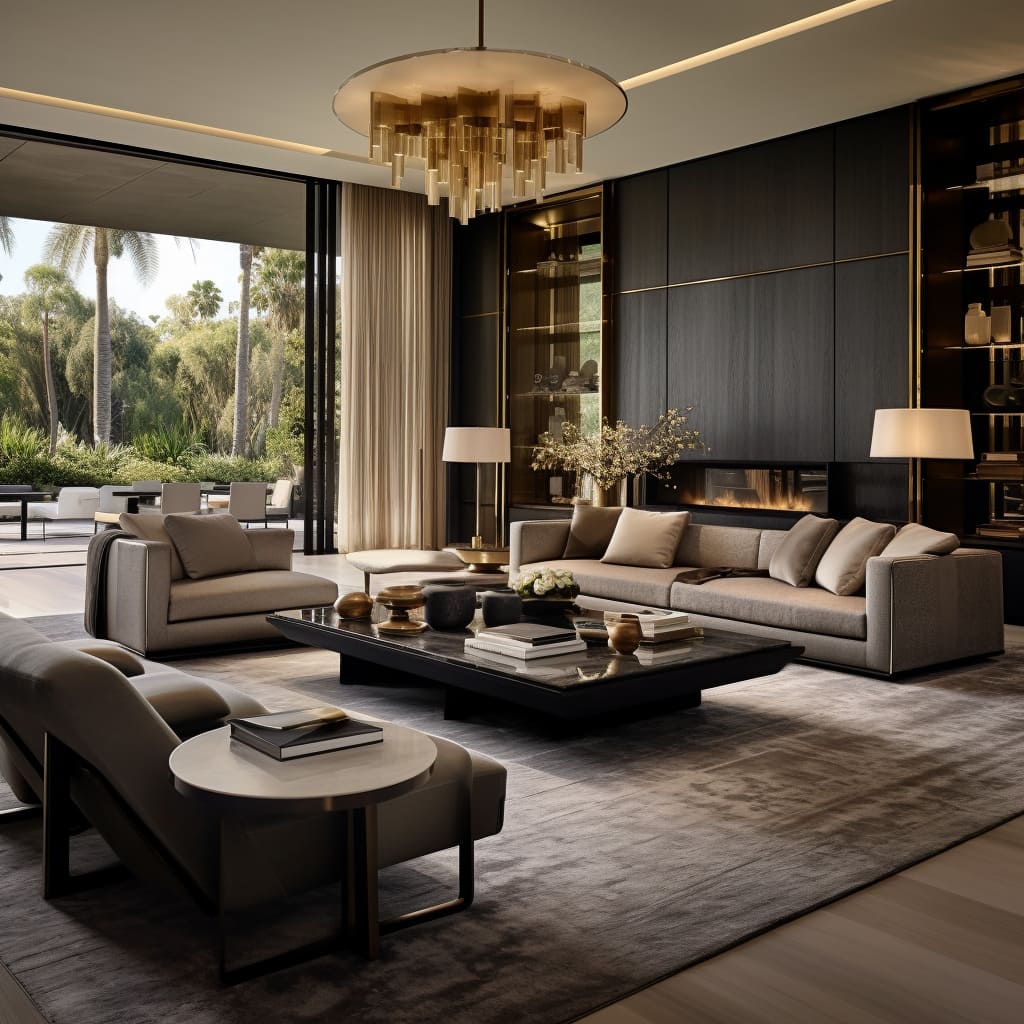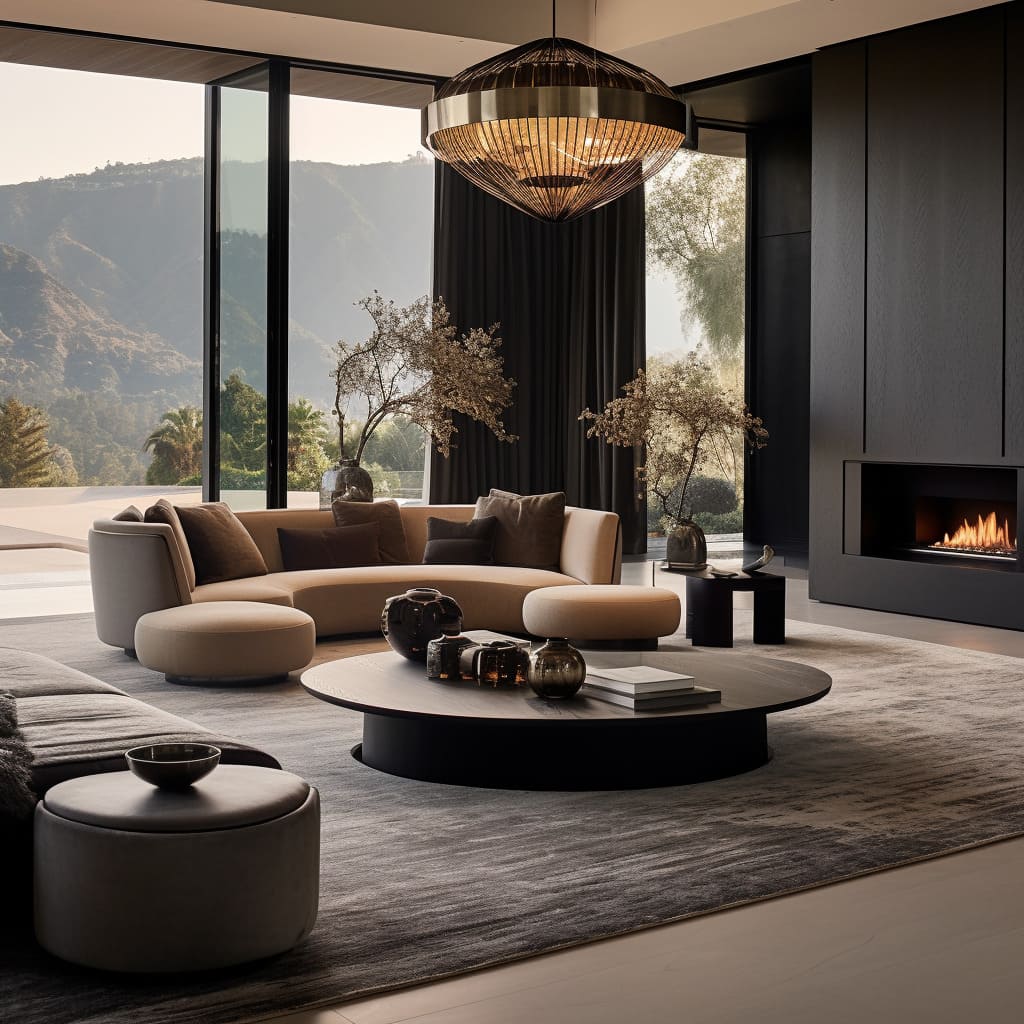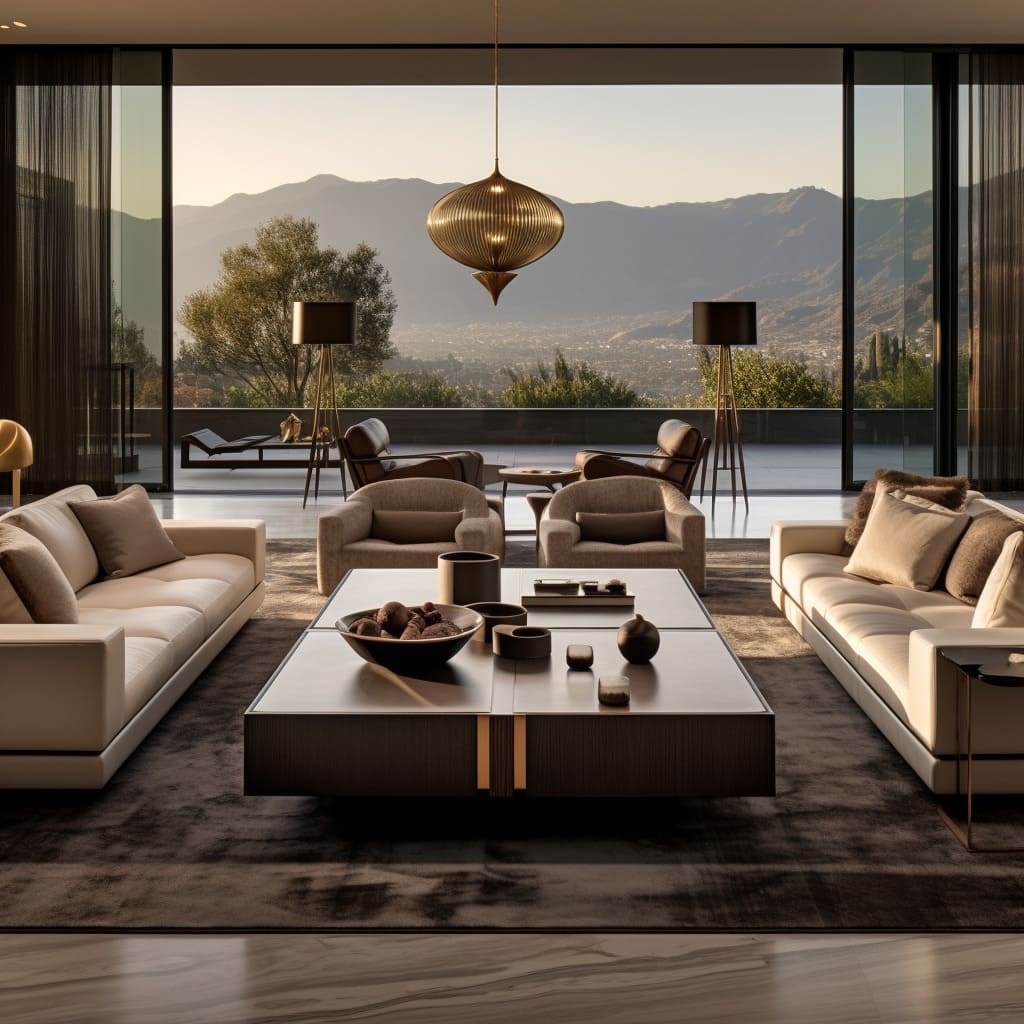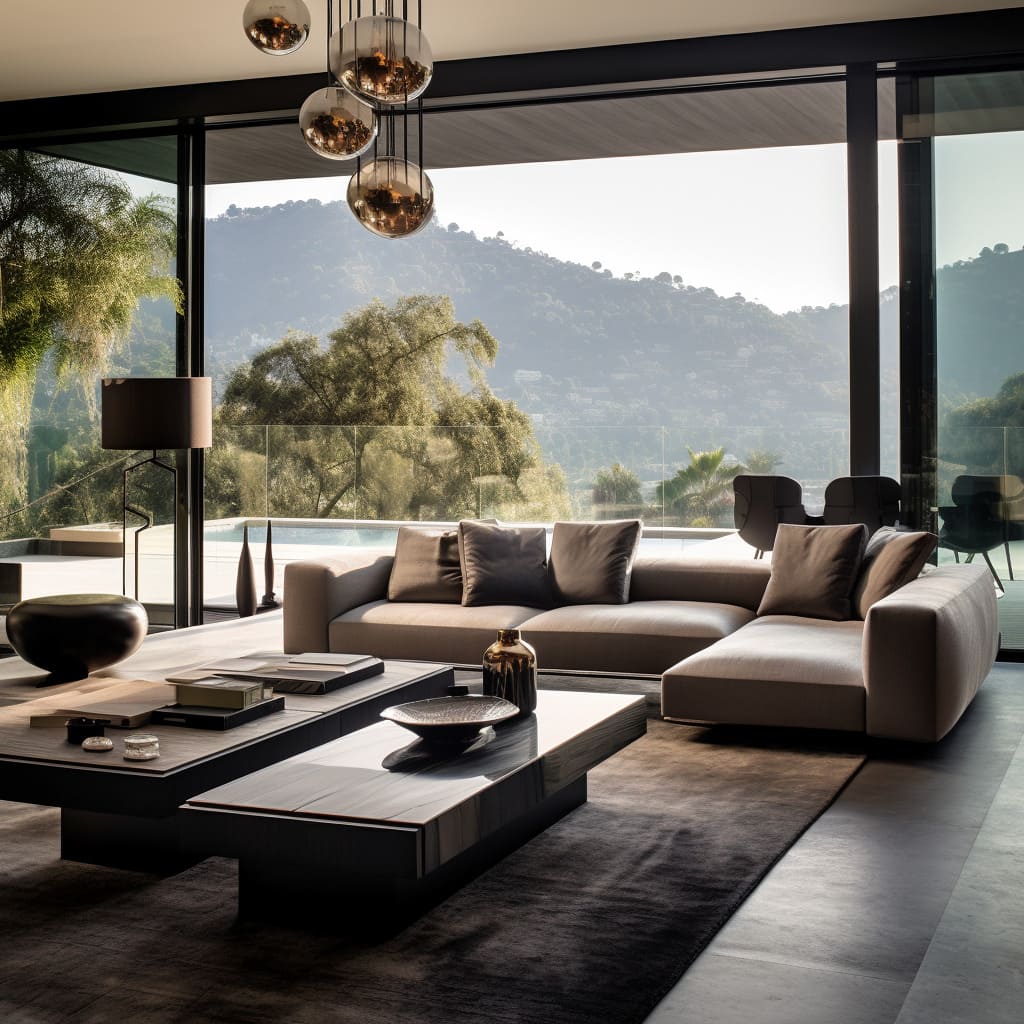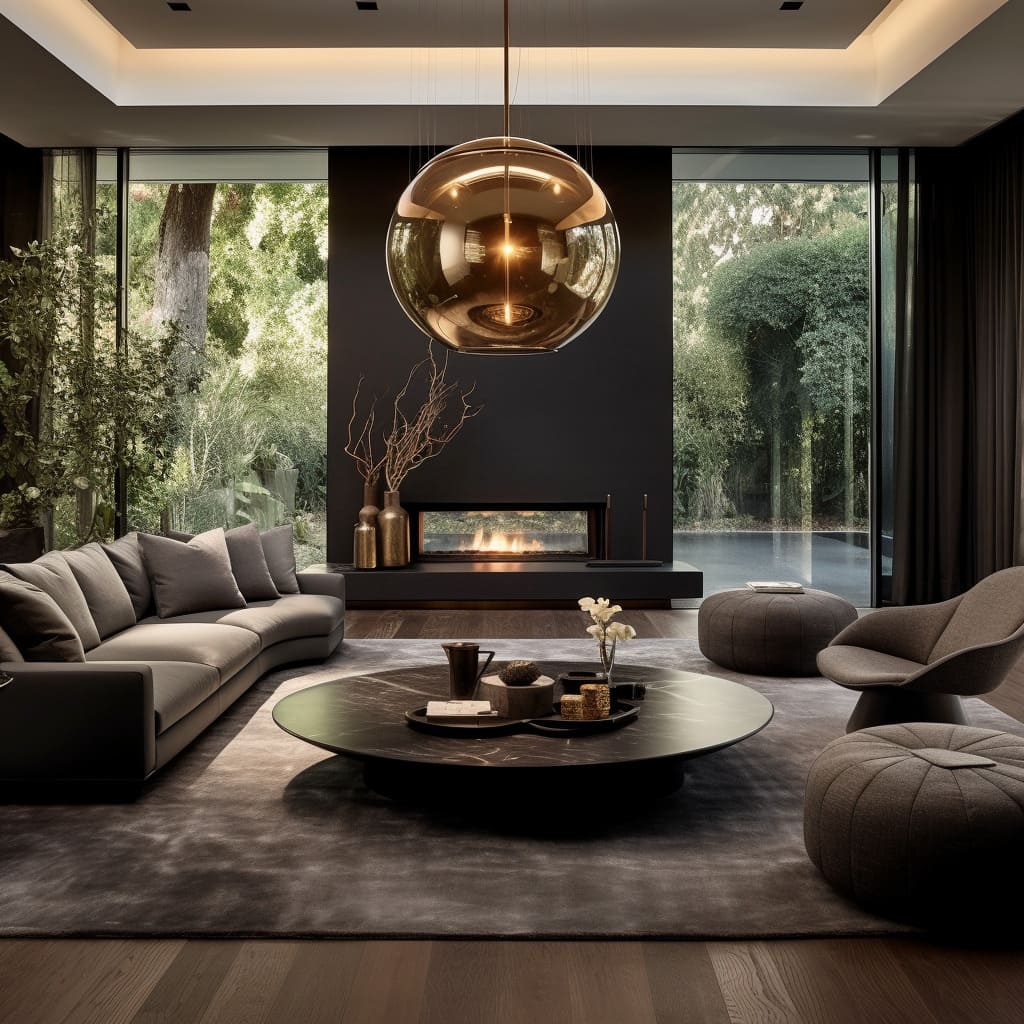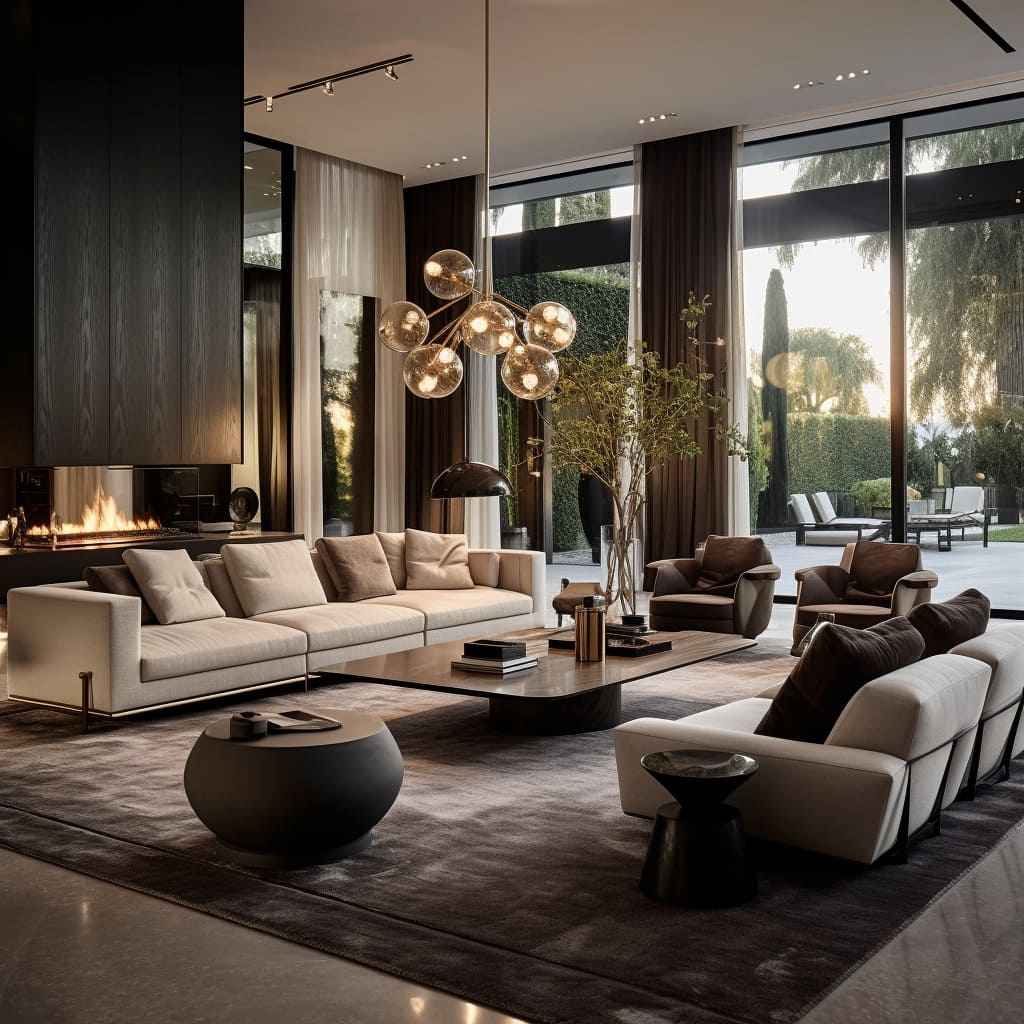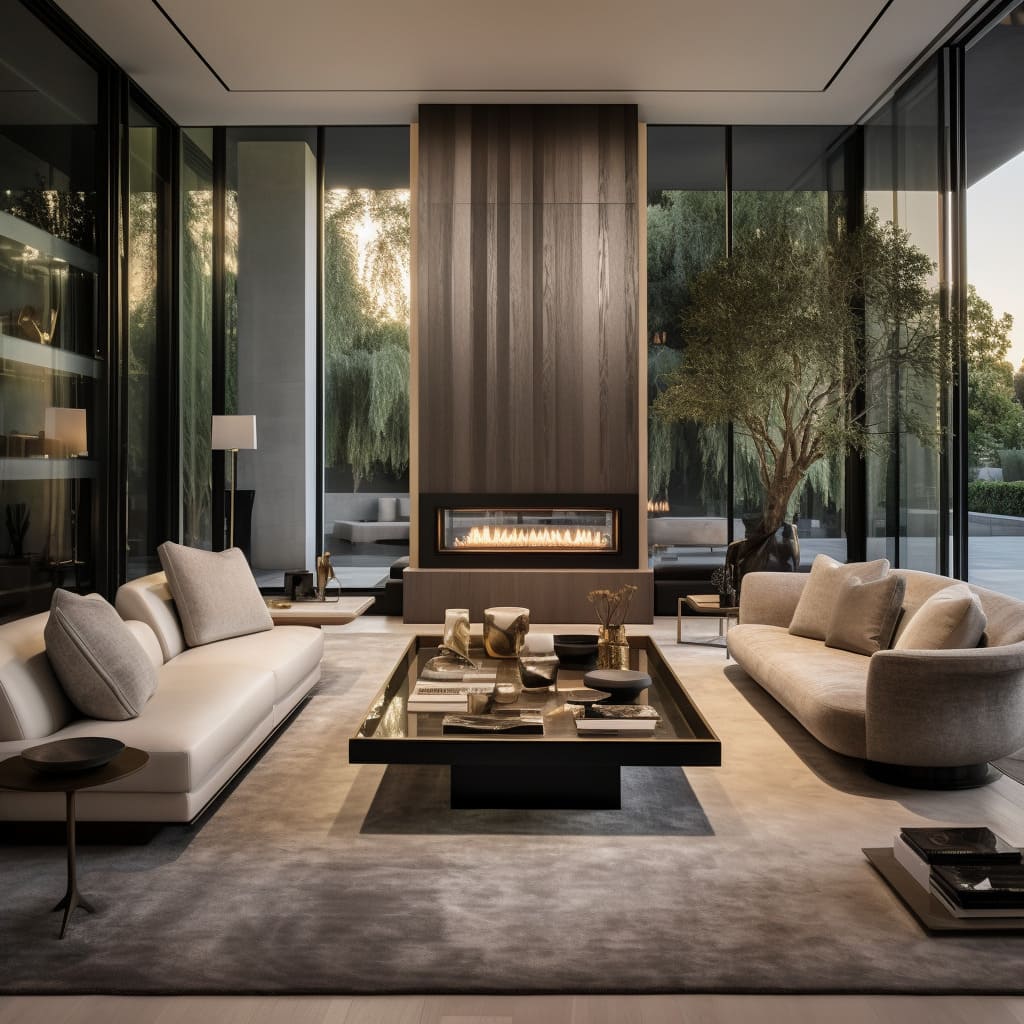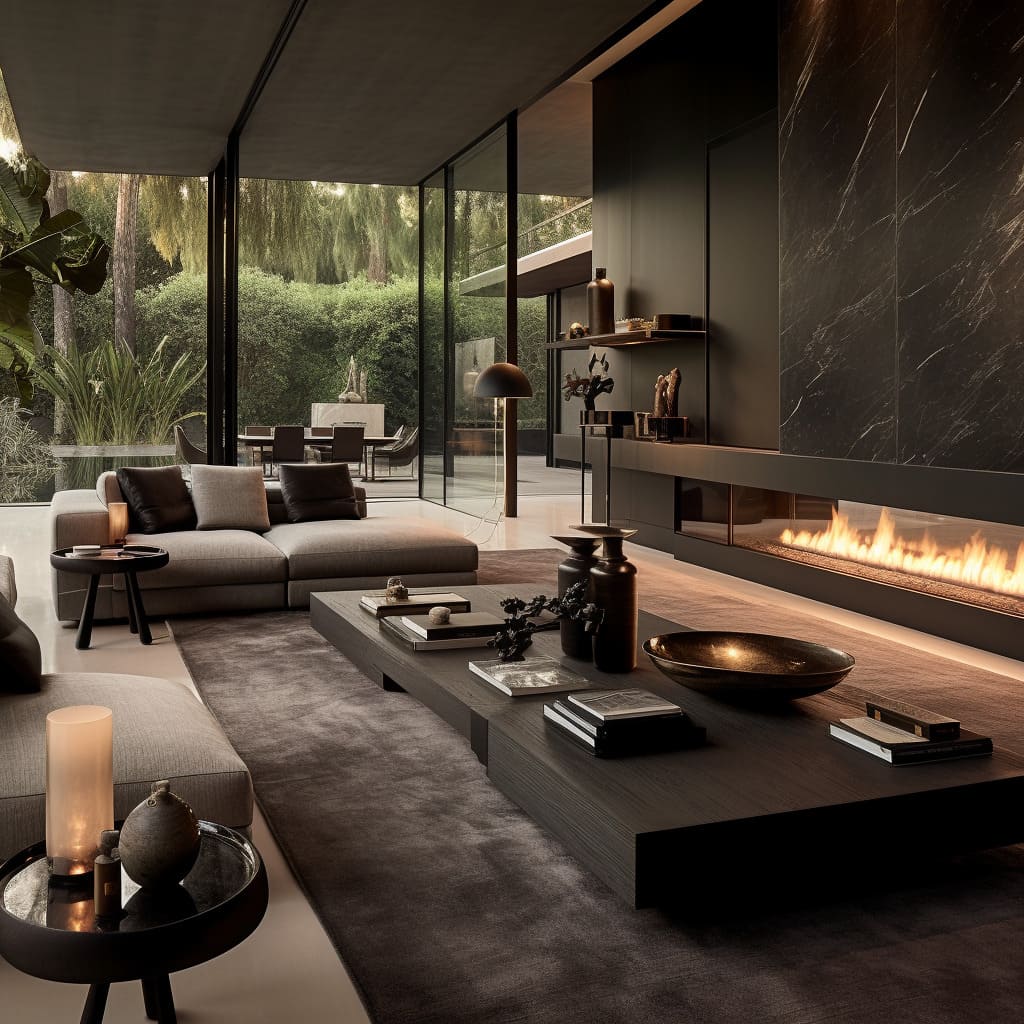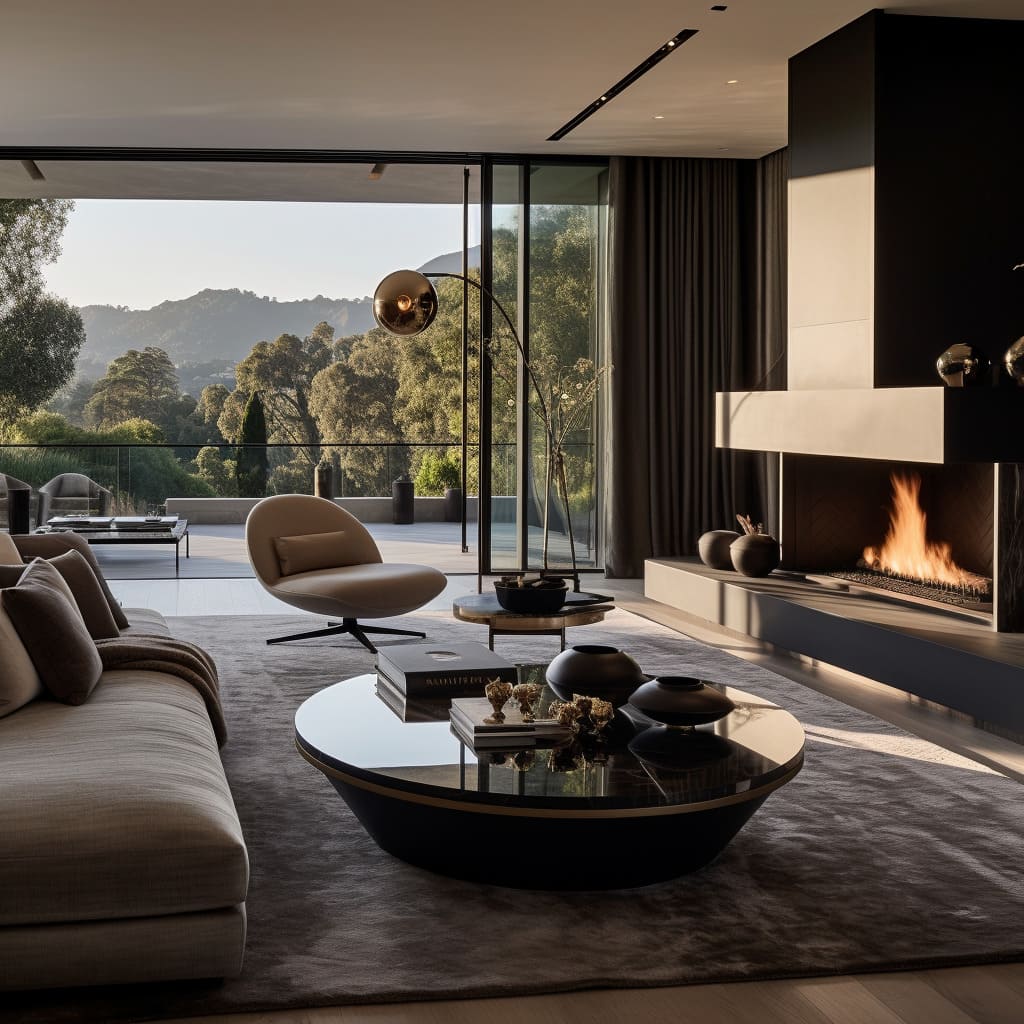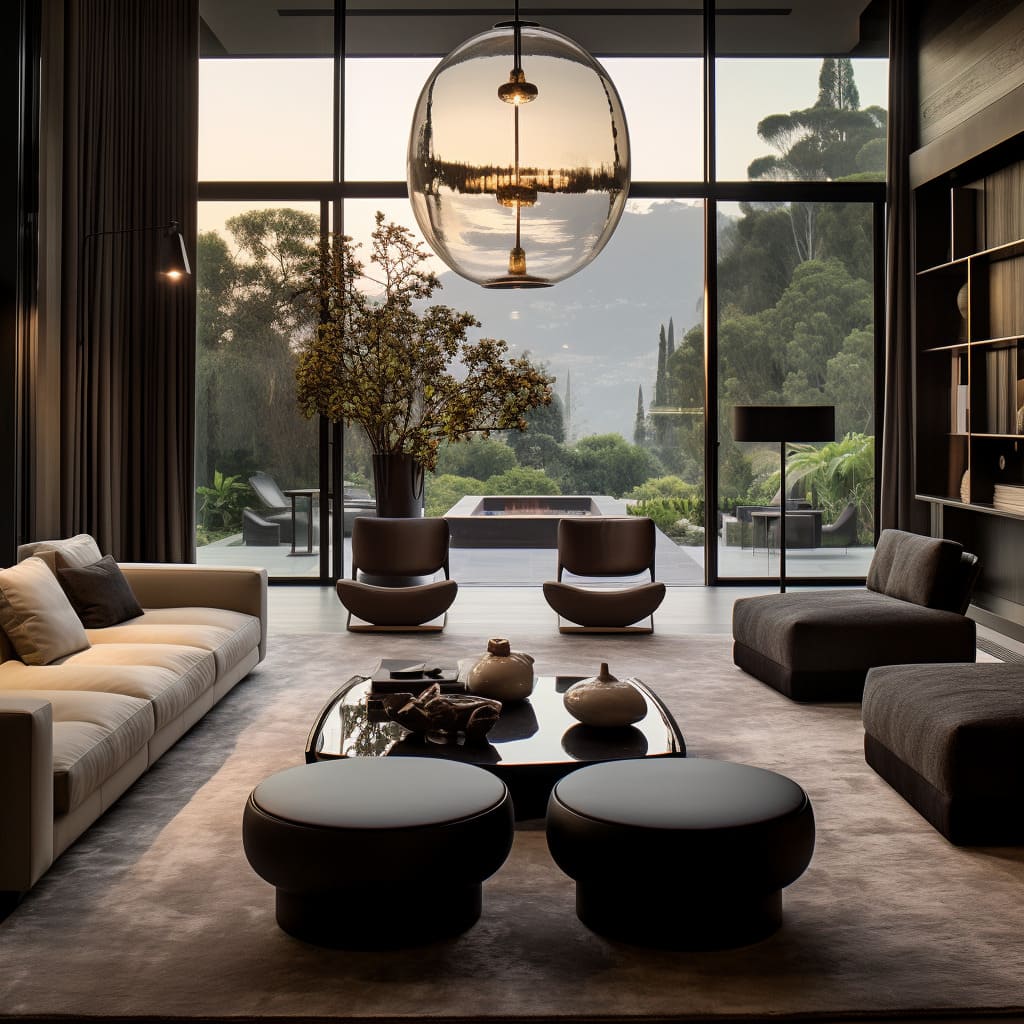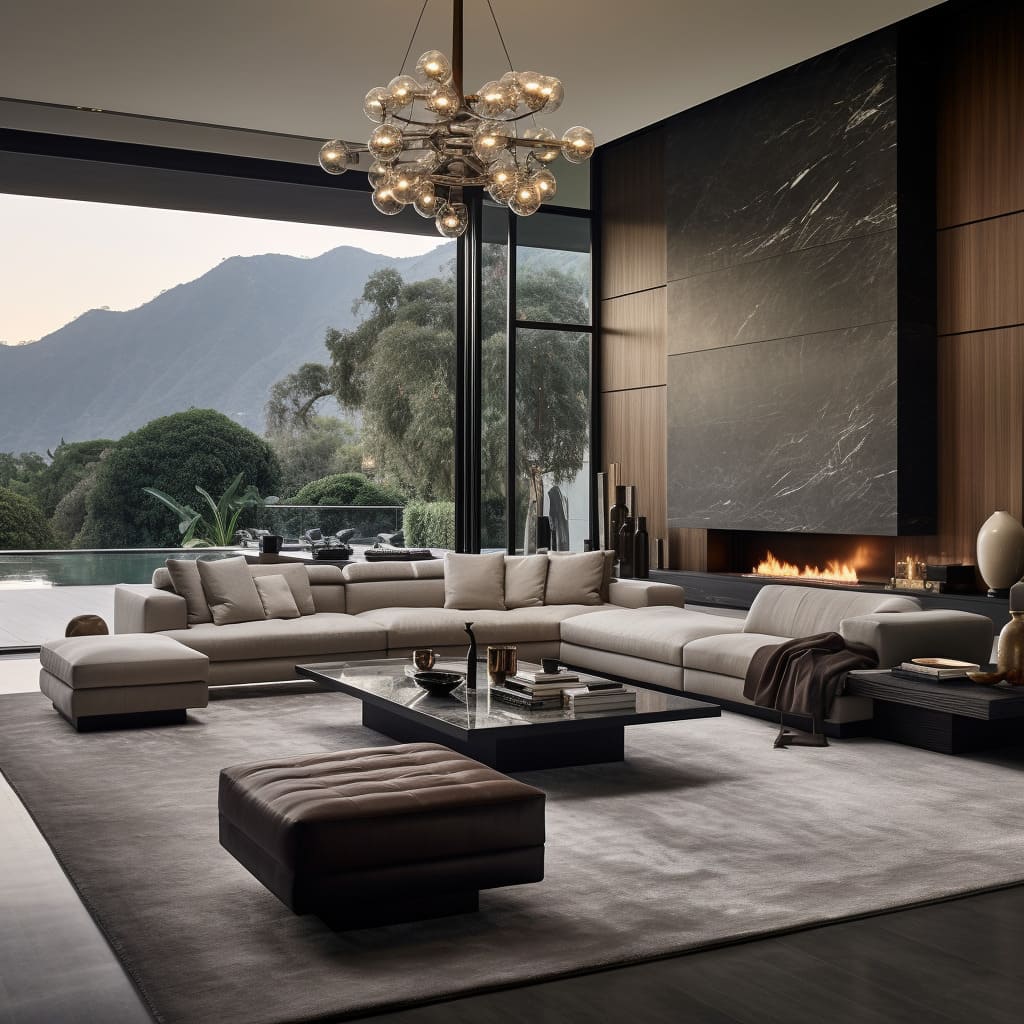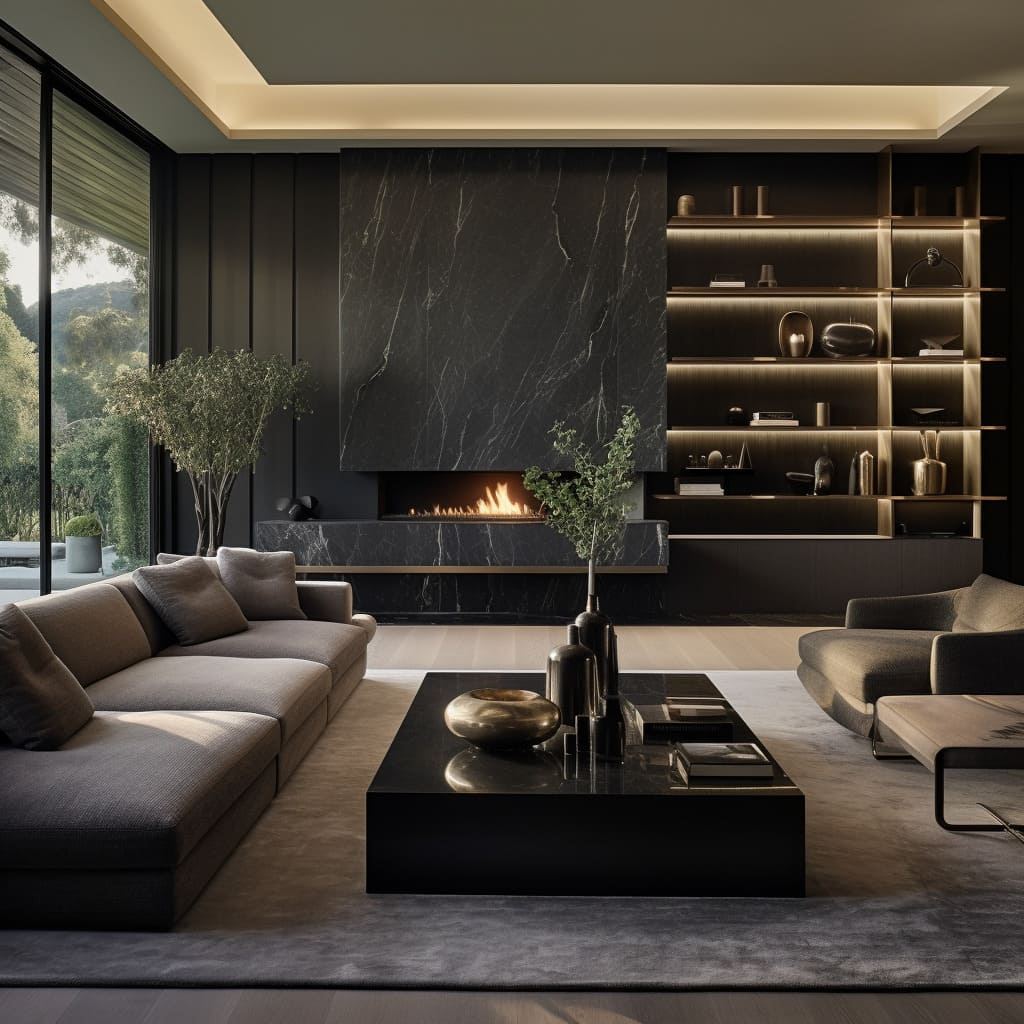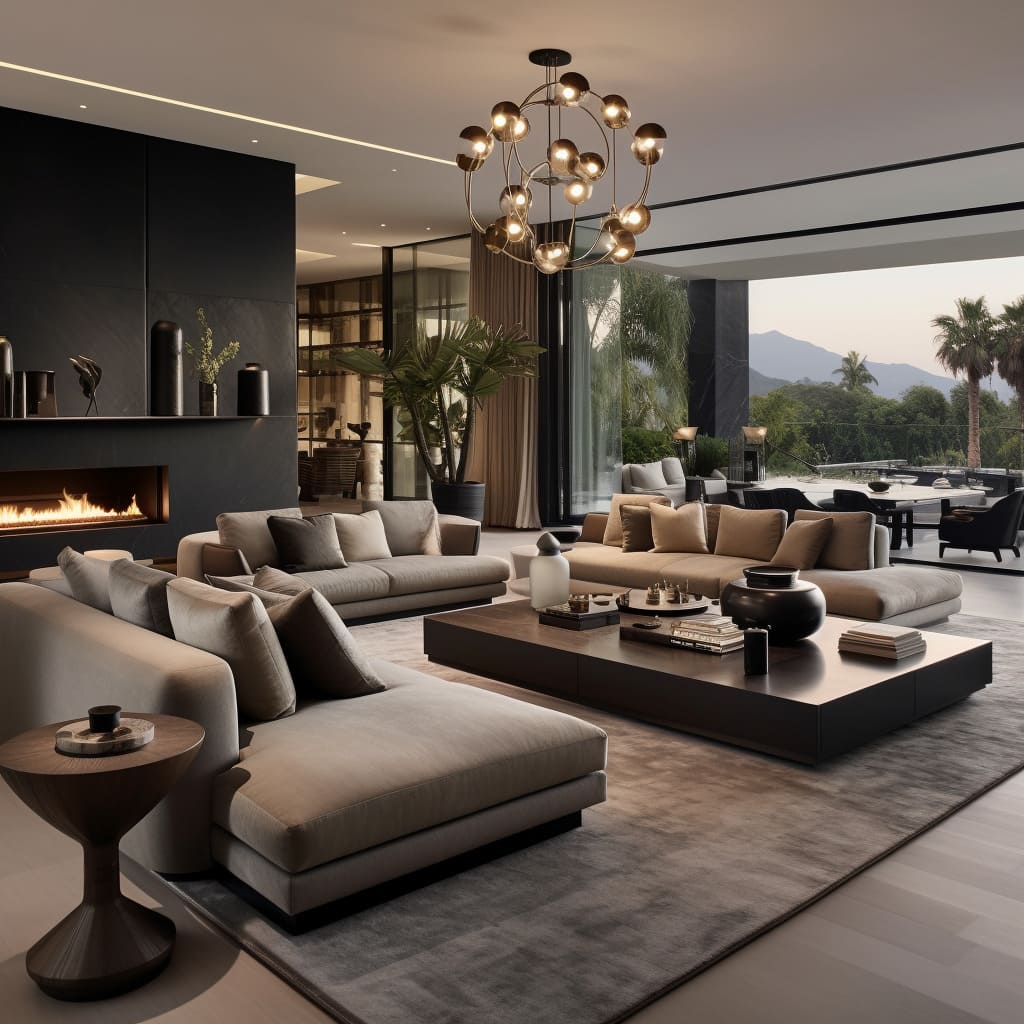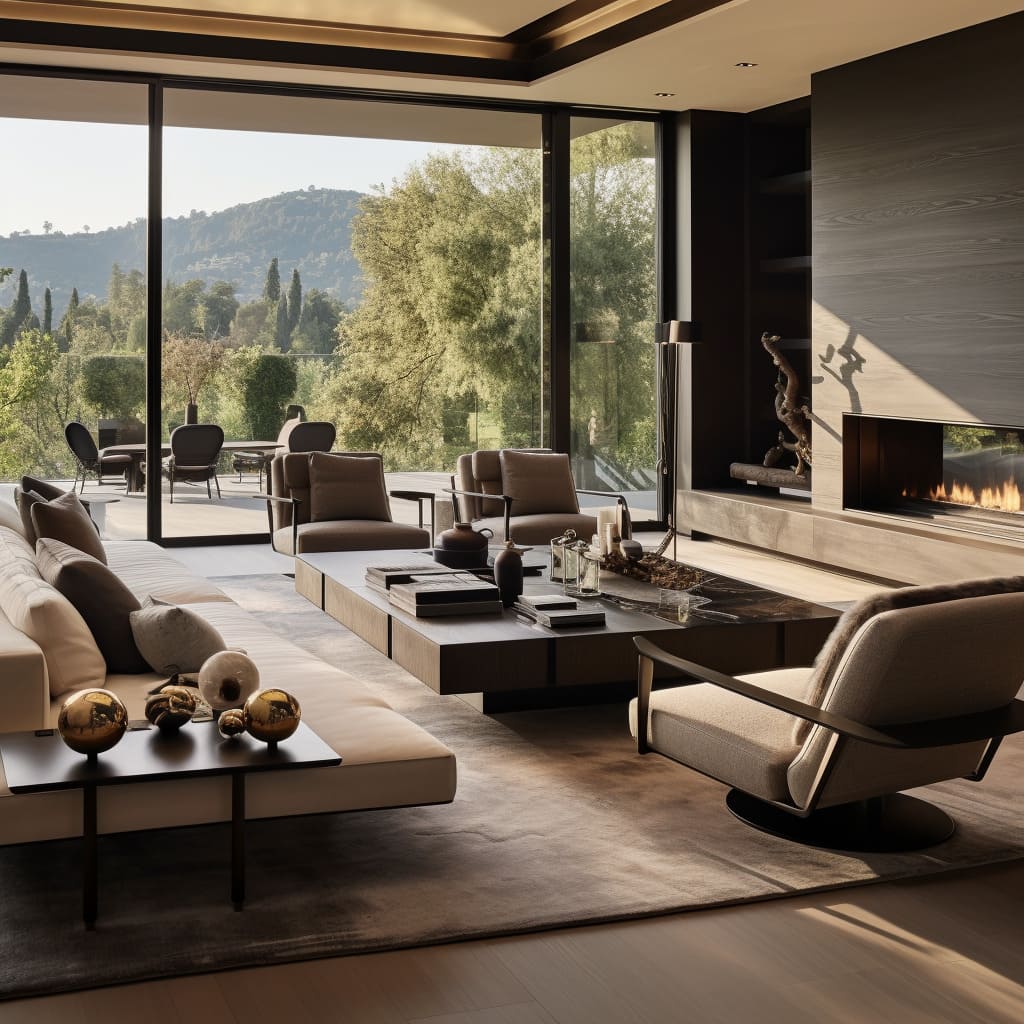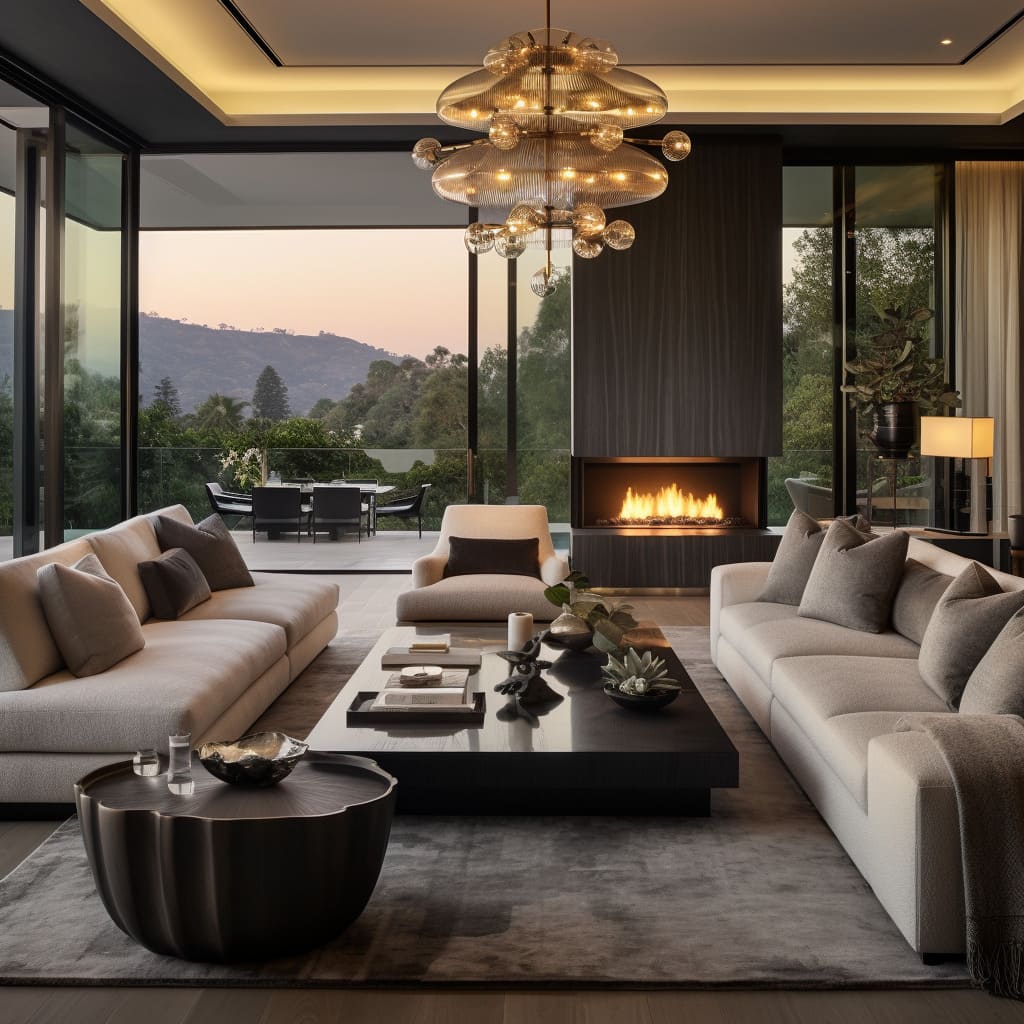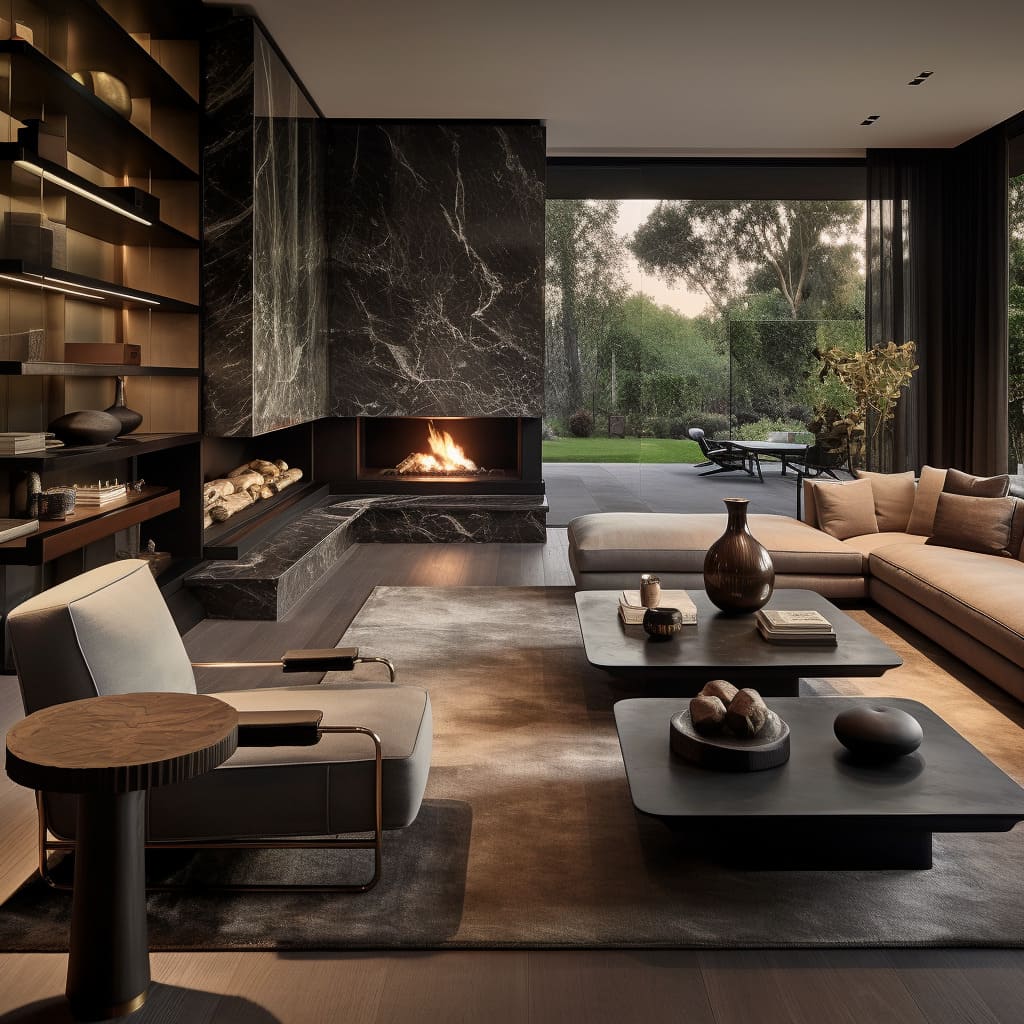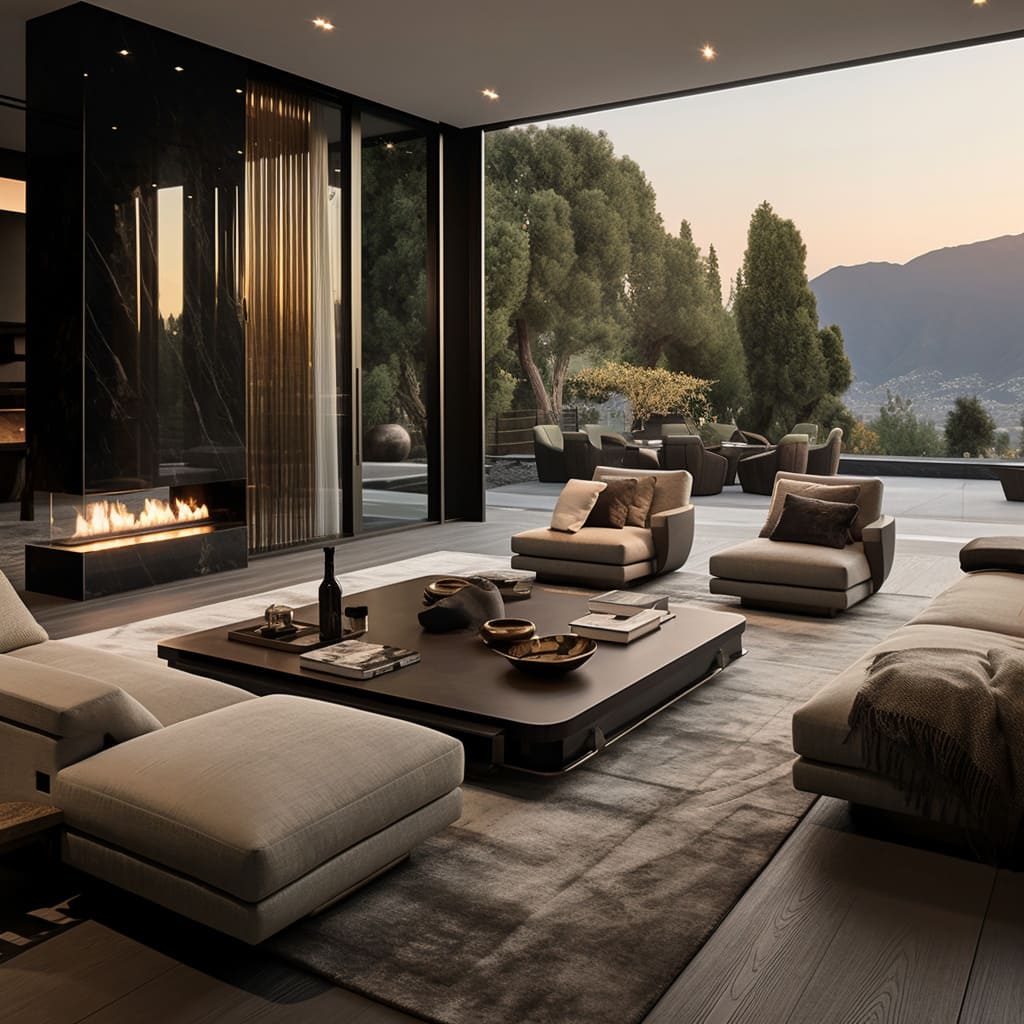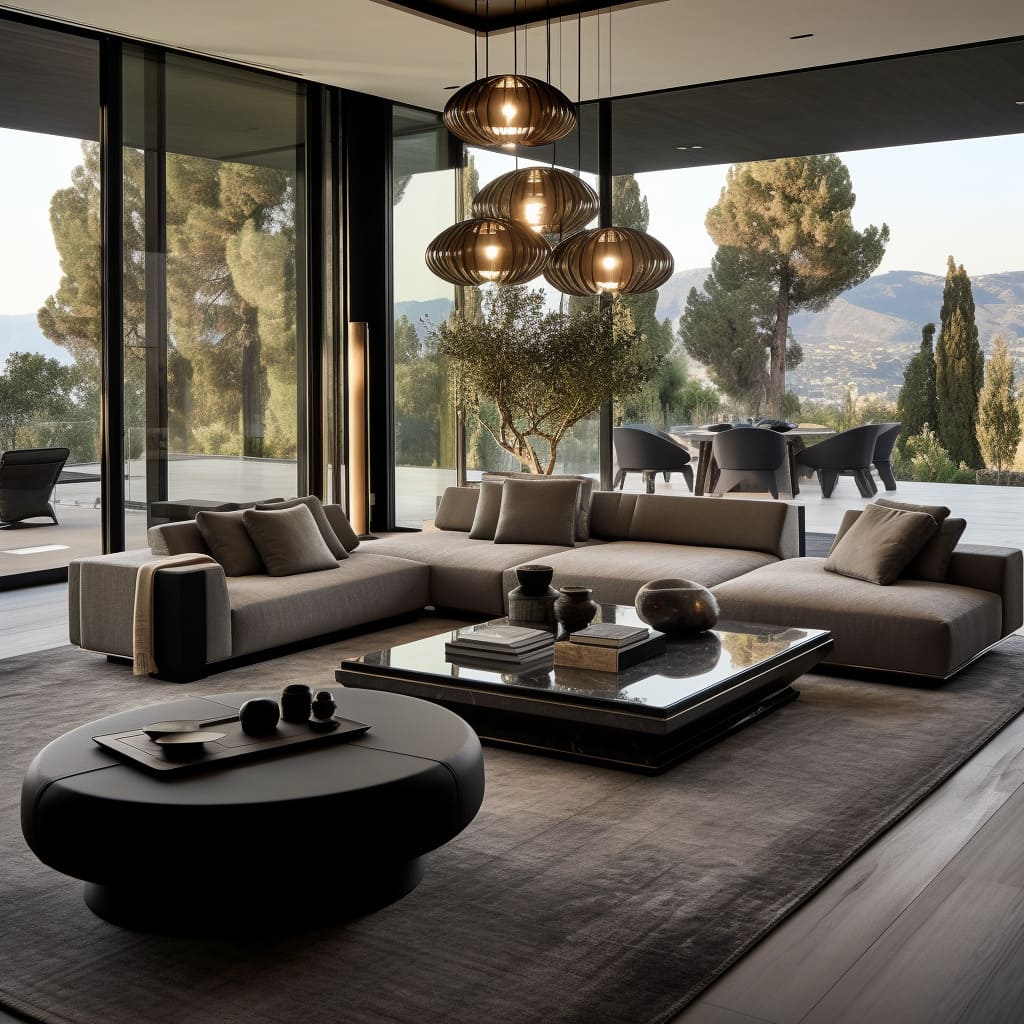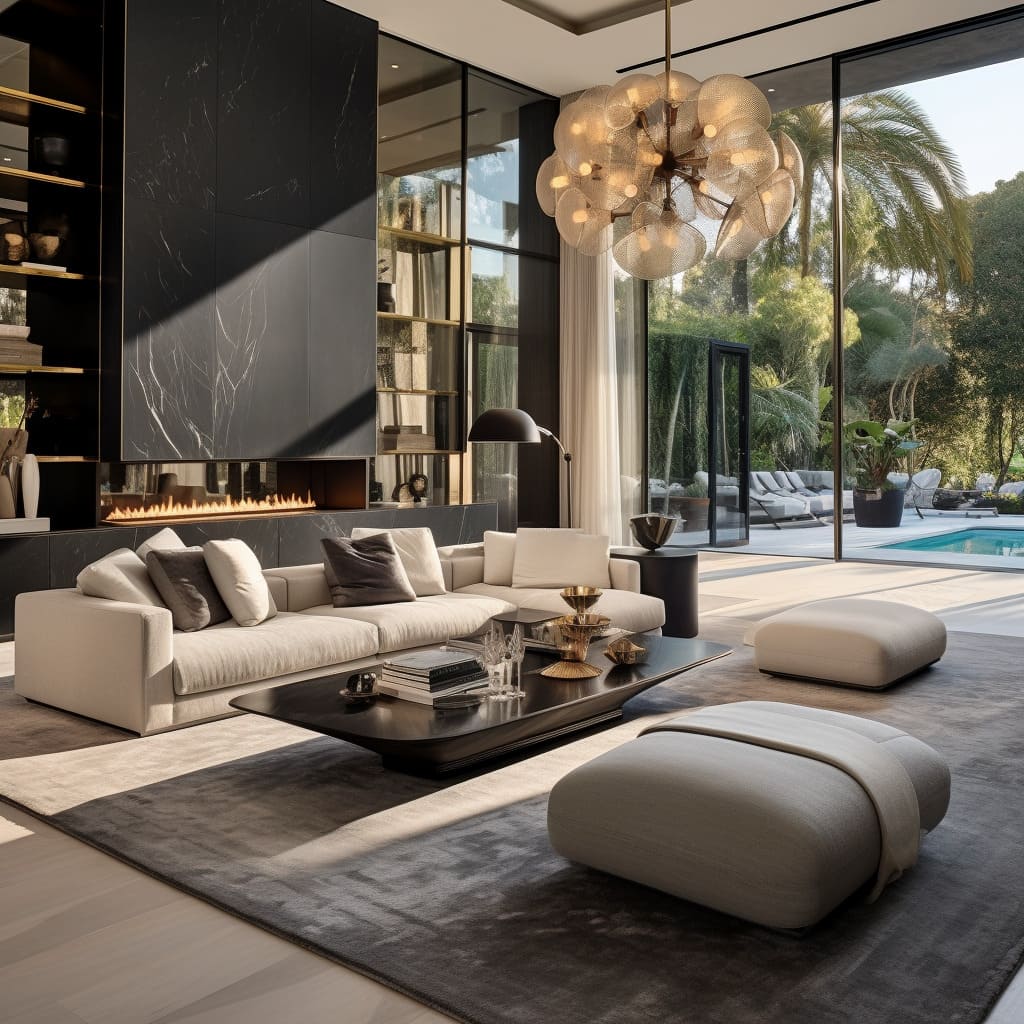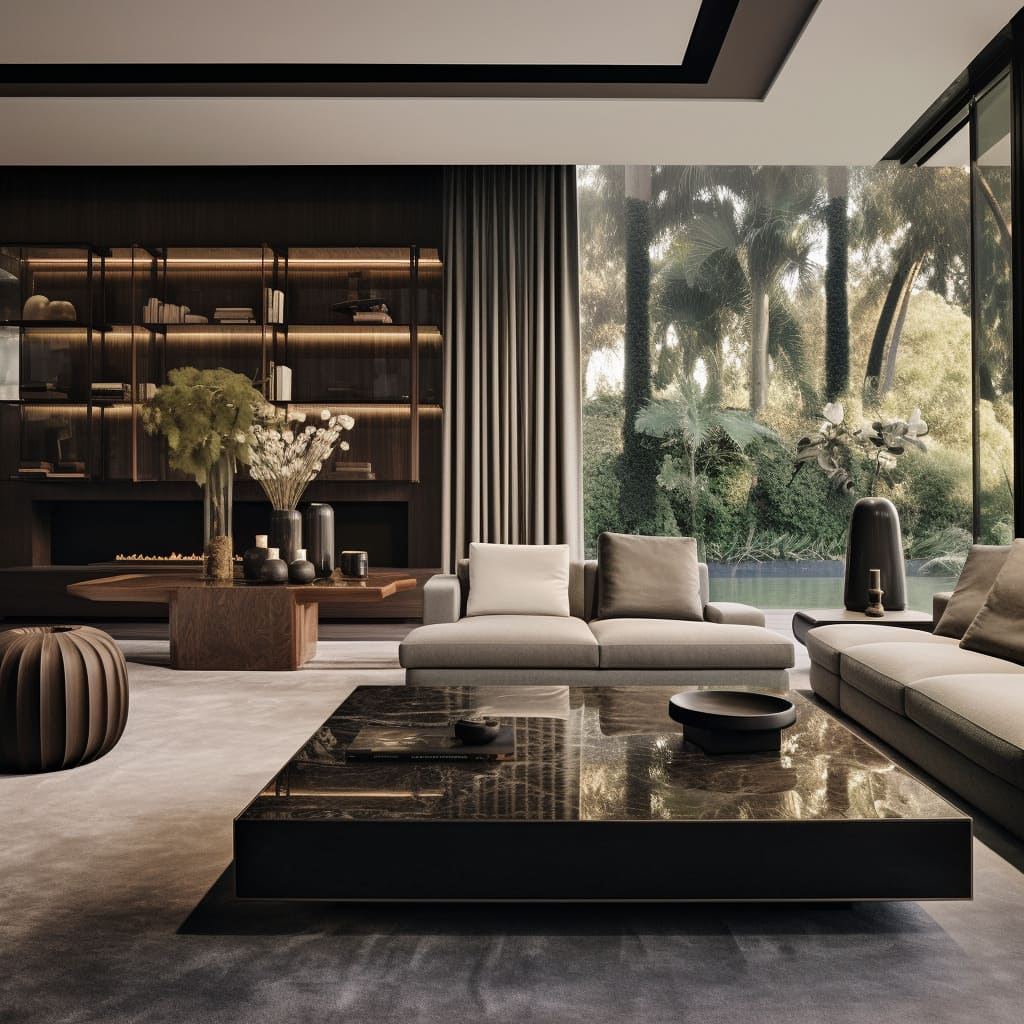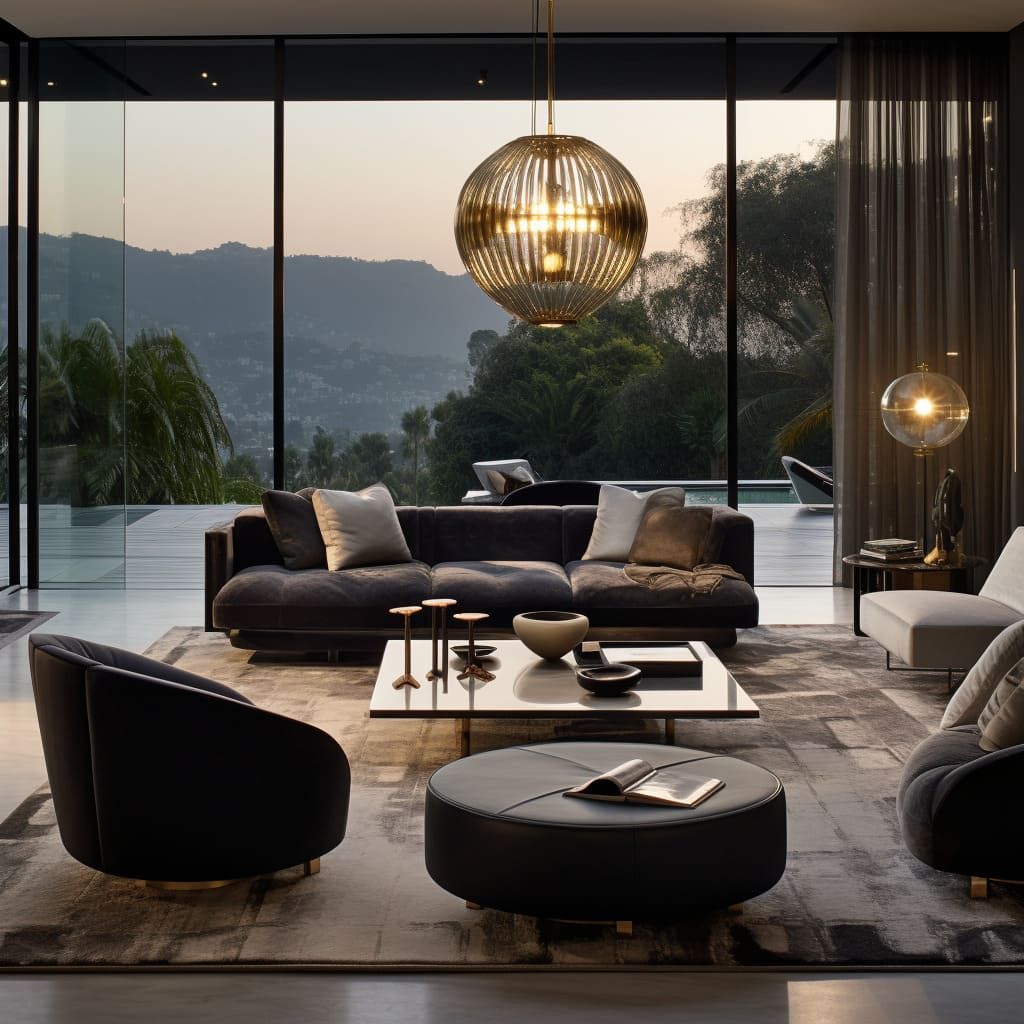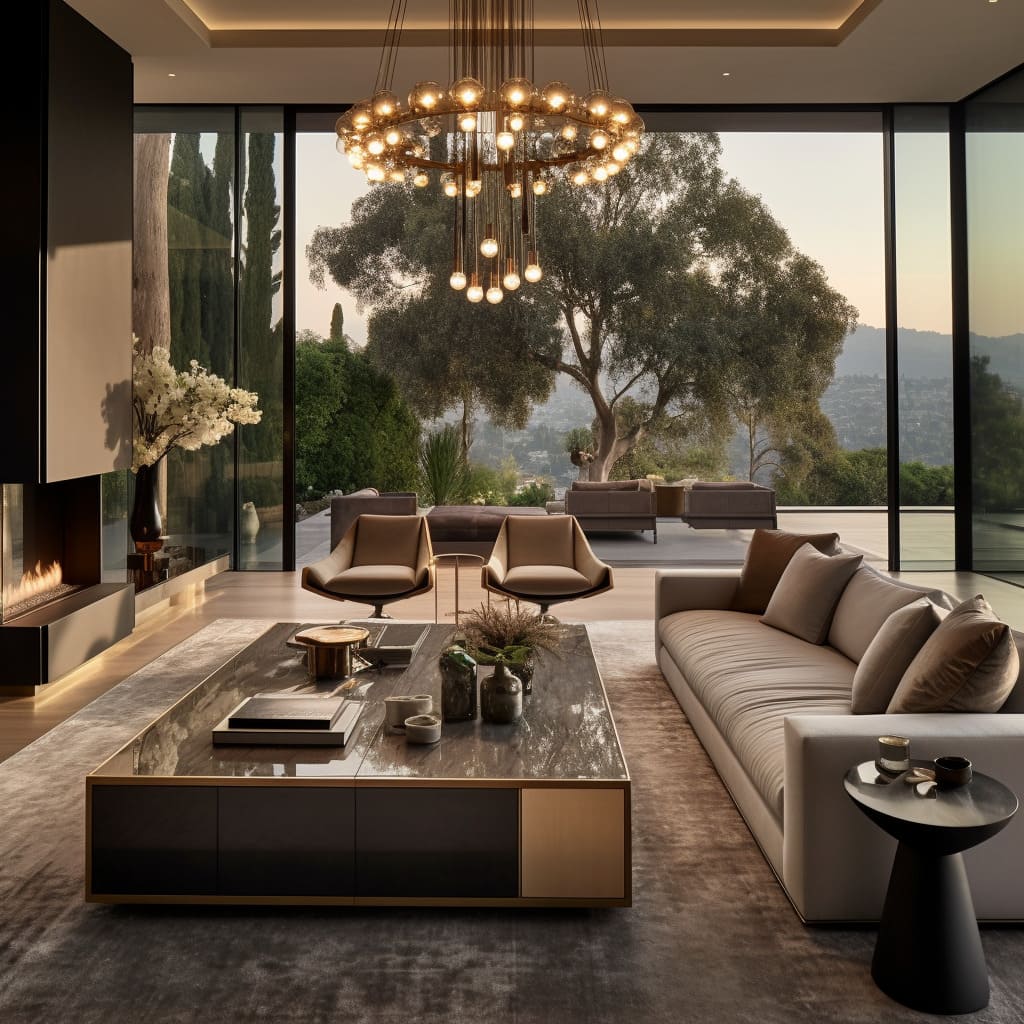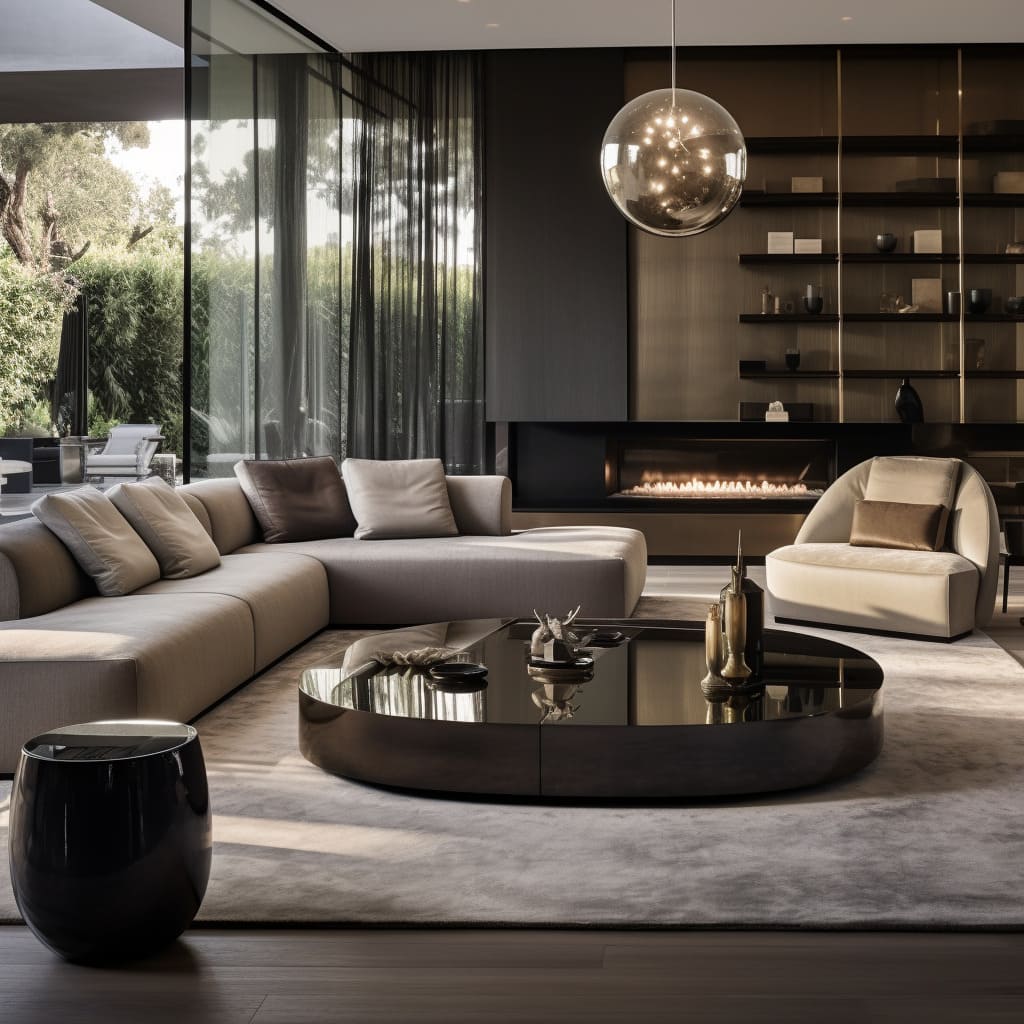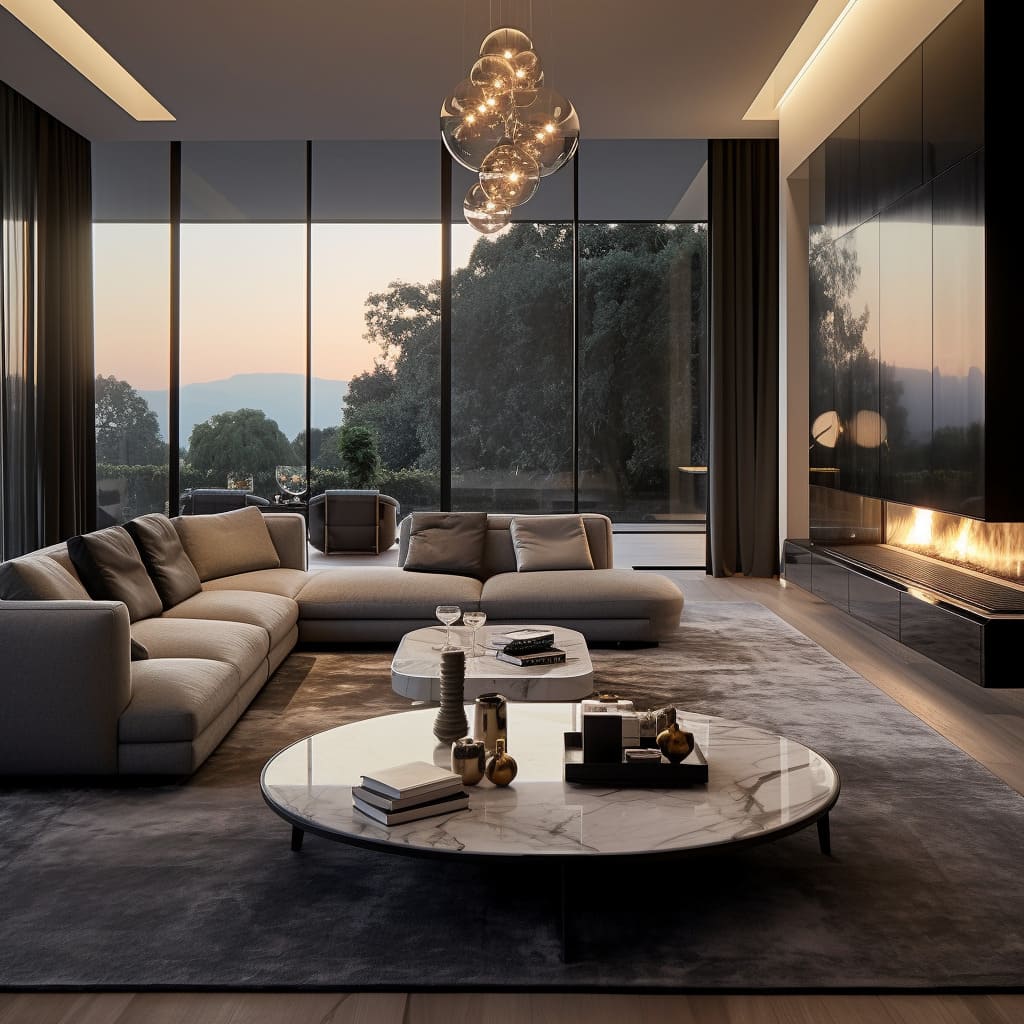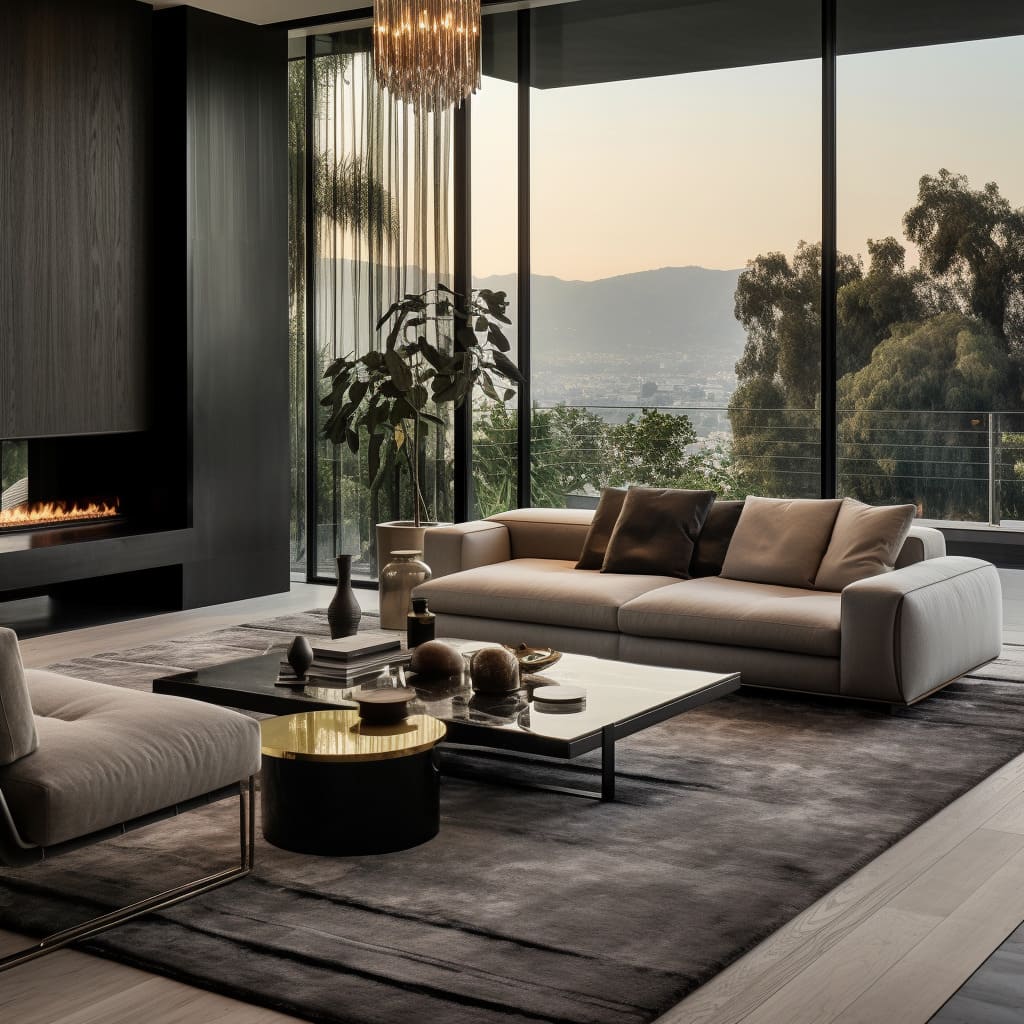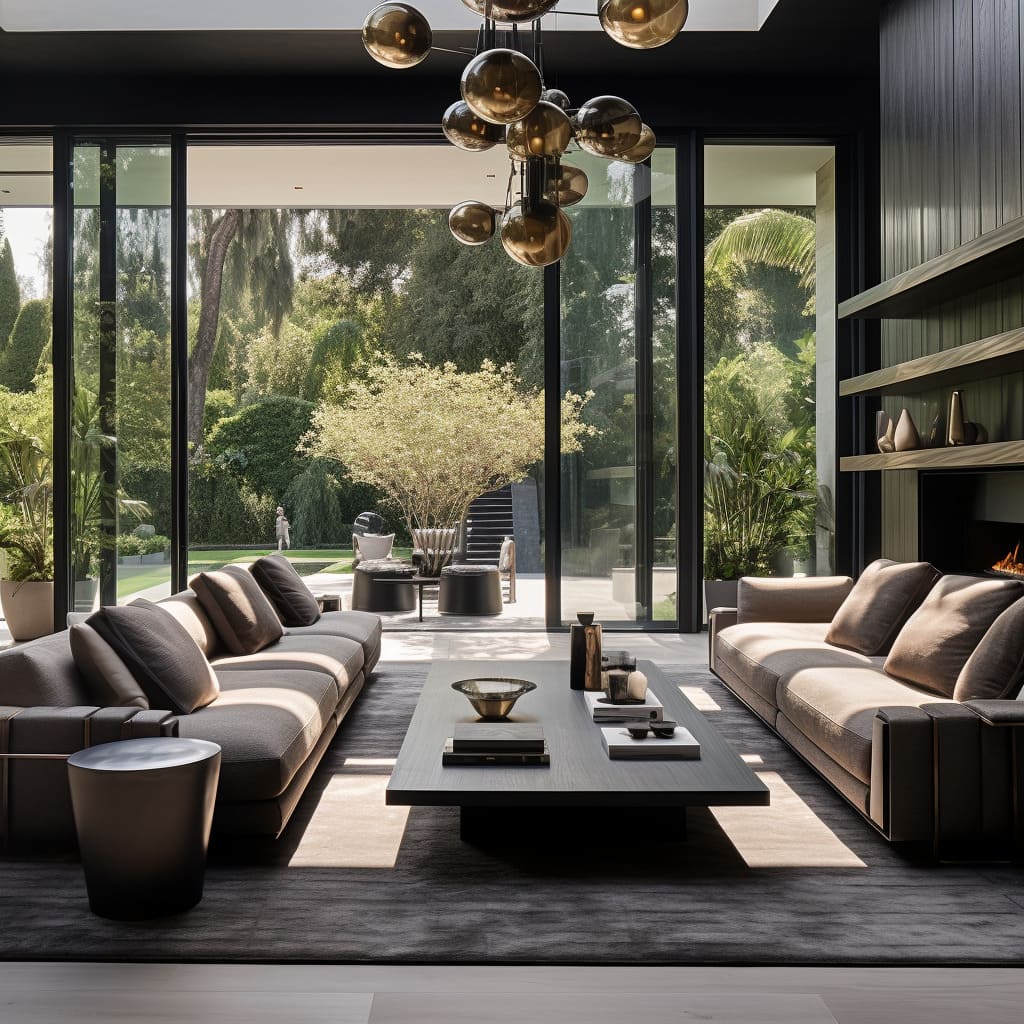In the heart of a well-designed home, the living room stands as a sanctuary of style and peace. Embracing the minimalist luxury aesthetic, such spaces are masterfully created to offer both comfort and elegance.
With a focus on high-quality materials, a harmonious color palette, and a connection to the natural world, these living rooms become a serene retreat that is modern, yet timeless.
The Minimalist Ethos
In contemporary luxury living rooms, the ethos of minimalism champions a design that is as much about the space you inhabit as it is about the space you allow to breathe. Employing a neutral color palette — a spectrum of beige softening into the depths of browns and the starkness of blacks — these living rooms embody a sophistication that is both inviting and reflective.
This minimalist approach is not merely an aesthetic choice; it’s a deliberate embrace of spaciousness and natural light, allowing the room to open up and breathe, offering a respite from the clutter and chaos that often fill our lives. This philosophy is deeply rooted in the belief that true luxury lies in the quality and placement of items, not in their abundance.
It’s about creating an ambiance where the design elements are so harmoniously integrated that the room itself seems to take a deep, calming breath, enveloping its inhabitants in a sense of calm and openness that transcends the traditional confines of home decor.
Furniture as a Statement of Elegance
In a minimalist luxury living room, the furniture does more than fill space — it makes a statement of elegance. Consider the sofa: it is often the largest piece in the room, but when chosen carefully, with clean lines and a soft, elegant hue, it becomes more than a seating option; it becomes a central piece of the living room’s narrative.
Adorned with plush pillows in shades that echo and complement its form, the sofa invites relaxation and serves as a testament to the aesthetic purity that minimalist luxury stands for. In such spaces, furniture transcends its functional purpose, serving instead as an anchor of style, an embodiment of elegance, and a reflection of the meticulous thought that goes into every aspect of the room’s design.
Aesthetics and Functionality
The interplay between aesthetics and functionality is nowhere more evident than in the center of the room, where a low-profile coffee table stands opposite the sofa. It is here that the room’s palette grounds itself, in the deep, rich hues of charcoal or black, which provide a visual anchor to the space.
This table is more than a surface; it is a stage for decor that has been deliberately chosen for its ability to convey personal style and taste. Abstract sculptures in metallic finishes and a selection of hardcover books do not merely fill space; they communicate a love for the arts and a penchant for intellectual engagement, blending practicality with personal expression.
The decor is minimal but meaningful, each piece conversing with the others and with the room itself, creating a narrative of curated aesthetics that is as functional as it is visually compelling. This is the essence of minimalist luxury — a space where every item is chosen not just for its beauty or utility but for its ability to contribute to a cohesive and tranquil atmosphere that is both lived in and lived with.
Accents of Opulence
In the refined canvas of a minimalist living room, even the subtlest of accents are selected with the intent to enrich the narrative of luxury. A side table, for instance, gleaming with a golden finish, isn’t merely a functional piece; it stands as a sculptural element, a nod to opulence amidst the calm.
This is not gold that screams of excess but whispers of elegance, catching the light to cast warm reflections that dance across the room, enhancing the depth and dimension of the space. Its presence is a deliberate contrast to the room’s neutral tones, a singular beacon that draws the eye and bestows an air of sophistication.
This careful curation extends to other accents — perhaps a vase that holds the simplicity of a single stem or the complex texture of a wild bouquet, or a lamp whose design is as much about the shadow it casts as the light it gives. Each piece, while useful, stands alone as a work of art, contributing to a cohesive aesthetic that balances understated grace with moments of visual delight.
Textural Contrasts and Comfort
Beneath the orchestrated symphony of furniture and decor lies the foundation of comfort in the form of an area rug. Its expanse stretches across the floor, a canvas in its own right, faded gray in color, suggesting stories and histories with its every thread and weave.
This rug does not boast a vibrant array of colors or complex patterns; rather, it exudes a quiet confidence with its understated design, providing a plush island amidst the sleek architecture of the room. It is a juxtaposition of the modern and the timeless, offering a sanctuary of warmth against the cool, hard lines of the floor beneath, which might shine with the luster of polished hardwood or the meticulous imitation of high-grade laminate.
Together, they create a textural dialogue, a tactile experience that invites the inhabitants to walk barefoot, to feel grounded and connected to the very fibers of the home.
Natural Light
Natural light plays a pivotal role in the minimalist living room, transforming the space with each passing hour. Expansive floor-to-ceiling windows act as ever-changing canvases, showcasing the living artwork of the outdoors.
They are portals to the world beyond, framing views that bring the serene chaos of nature into the realm of the structured interior.
The play of light through these windows is a daily theater — the gentle luminescence of dawn, the bright zenith of noon, the fiery palette of dusk, and the contemplative glow of twilight. Such windows are adorned with gossamer curtains that billow softly with the breeze, filters that allow residents to modulate the inflow of light and privacy.
They enhance not just the view but the entire ambiance of the room, creating an essential connection with the elements and ensuring that the living room breathes in tandem with the time of day and the mood of the sky.
Outdoor Harmony
The living room’s relationship with the outdoors is an intimate dance of harmony and reflection. The careful landscaping that is glimpsed through the windows is more than a view; it is an extension of the living space.
An infinity pool sits at the edge of this design, its waters a mirror to the vastness of the sky, a physical embodiment of luxury that merges with the natural horizon.
This outdoor vista is a living entity, shifting with the seasons, offering a spectrum of colors, textures, and moods that are in constant dialogue with the interior space. In summer, it may be a vibrant greenery that peers in, in autumn a tapestry of fiery hues, in winter a study in stillness and monochrome, and in spring a burst of rebirth and color.
This visual and visceral connection ensures that the living room is never static; it is a space that evolves, that breathes with life and vitality, offering residents a continuous renewal of scenery and spirit.
Ambient Illumination
Lighting in a minimalist luxury living room is orchestrated with a deft hand, sculpting the space with layers of light that can be as dynamic or as muted as the occasion demands. The primary source is often hidden LED fixtures, embedded within architectural details or behind furnishings, providing a diffuse glow that can shift in intensity and color to reflect the time of day or the desired mood.
These lights offer a softness that can make a room glow with warmth or recede into a calming dimness, reminiscent of the natural light of dusk or dawn. The addition of recessed spotlights, carefully placed to wash over an art piece or to highlight the rich textures of the room’s fabrics and materials, can turn an ordinary wall into a canvas and a simple sculpture into a statement.
Dimmers play a crucial role in this subtle drama of light, allowing for the brightness to be fine-tuned, creating a sanctuary of illumination that can be as focused or as ambient as required. This nuanced lighting design ensures that the living room can serve multiple purposes, from a serene retreat for quiet contemplation to a vibrant stage for entertaining guests, all with the simple adjustment of light.
The Art of Color Balance
The palette of a minimalist living room is composed with an artist’s attention to balance and harmony. Color is not simply a matter of aesthetic pleasure but an essential component of design that influences mood and perception.
The base tones of the room are often neutral — whites, beiges, and greys — that serve as a canvas, setting a stage for deeper hues like charcoal or chocolate to provide depth and grounding.
Into this carefully controlled spectrum, accents are introduced: perhaps the rich gold of a side table, the burnished bronze of a sculpture, or the subtle blush of a throw pillow. These accents are not random; they are chosen for their ability to harmonize with the rest of the space, to bring warmth to the coolness of the neutrals, and to add a layer of complexity to the design.
The art of color in minimalist design is to use these hues sparingly but effectively, ensuring that each color, whether on a large scale like a feature wall or in a small detail like the spine of a book, contributes to a sense of balanced beauty that is soothing and inviting to the senses.
Textiles and Touch
In the tactile world of minimalist living rooms, textiles play a central role in defining comfort and luxury. The chosen fabrics for furniture are not merely coverings; they are an invitation to touch, to sit, to linger.
The upholstery of a sofa might be a rich linen, its texture natural and breathable, or a sumptuous chenille that begs to be stroked, both offering comfort and a whisper of luxury. Accent pillows in a complementary palette might boast a velvety finish, catching the light and shadows in a way that adds dimension and interest to the seating area.
Throws might drape elegantly over the back of a chair or the arm of a sofa, their cashmere or woven textures a functional accessory for cooler evenings.
These textiles are carefully selected not just for their color or pattern but for the way they feel against the skin, for the warmth they provide, and for the way they enhance the overall sensory experience of the room. Through the use of textiles, a minimalist living room becomes a place of tactile as well as visual comfort, an oasis of calm where every touch is a reminder of the luxury that simplicity can afford.
The Significance of Sculpture
Artistic expression within the minimalist living room finds its voice through sculpture. These pieces, whether poised on the coffee table or standing sentinel on a shelf, are more than mere ornaments; they are manifestations of form and texture, of history and personal journey.
A bronze piece, its surface bearing the complex patina of time, becomes a focal point, a tangible connection to the ancient art of metalwork.
Its shape might be abstract, inviting contemplation and interpretation, or it could be a more recognizable form that tells a specific story or evokes a memory. These sculptures are chosen for their ability to converse with the room’s other elements, their materiality — be it smooth stone, rough metal, or polished wood — adding another layer to the room’s textural narrative.
They serve not only as visual anchors but as touchpoints for the room’s aesthetic, tangible evidence of the homeowner’s tastes and preferences, and a reminder that in the minimalist philosophy, what matters is not the quantity of items on display but the quality of the conversation they inspire.
The Dynamics of Texture
In the understated elegance of a minimalist living room, textures emerge as a vital element, providing a counterpoint to the simplicity of the color scheme. They bring depth and interest to the space, inviting interaction and engagement.
The strategic use of a variety of textures — from the coarse weave of a throw pillow to the smooth finish of a leather pouf — adds a tactile dimension that enriches the user experience.
The rug, with its gentle pattern, provides not only visual relief but also a softness underfoot, a comforting presence in a sleek space. Even the walls may have a subtle texture, with a matte finish or a touch of grain, to absorb light and create a soft backdrop for the rest of the room.
Textural variety is introduced carefully to maintain the minimalist aesthetic; it’s about finding the balance between feeling barren and becoming overly busy. Each textural choice is made with an eye towards creating a layered experience that speaks to the sense of touch as much as to the sense of sight, ensuring that the minimalist living room is a place of comfort as well as beauty.
Furniture as Functional Art
In a minimalist living room, the furniture serves dual purposes, existing at the intersection of functionality and artistry. Each piece, selected for both its form and its function, plays a pivotal role in the overall design.
The coffee table, for instance, is more than just a surface for beverages and books; it’s a statement piece that anchors the room — its material, shape, and size are all reflective of the design ethos. It could be a sleek metallic structure that reflects the room’s ambient light, a slab of natural wood that adds warmth and texture, or a piece of clear glass that provides a surface without visual weight.
Similarly, a pouf or an ottoman is not merely an add-on for seating; it’s a versatile and movable piece that can serve various needs. It may be used as a footrest for relaxation, an impromptu table for a tray of refreshments, or additional seating for guests.
The design of these pieces often straddles the line between minimalism and sculpture, with clean lines and thoughtful proportions that make them stand out as individual works of art within the functional landscape of the living room.
Architectural Statements
The architecture within a minimalist living room is itself a form of expression, contributing to the space’s narrative and setting the stage for the interior design. Structural elements like a bold column or an artfully recessed ceiling can transform the room, adding a layer of drama and focus.
The interplay of light and shadow on these structures adds dynamism to the room, with the changing natural light highlighting different facets and textures throughout the day. The choice of materials for these elements, from raw concrete to polished stone, also contributes to the sensory experience of the space, making the architecture not just the bones of the living room but also a critical component of its aesthetic soul.
Living in Art
The minimalist luxury living room transcends the traditional concept of a living space; it is a living art form. Each element, from the largest furniture piece to the smallest decorative object, is chosen with consideration for its contribution to the aesthetic and functional harmony of the room.
The space is designed to be both expansive and intimate, with the careful arrangement of furniture and decor creating open areas for movement and smaller pockets for personal retreat. The boundaries between furniture and sculpture, between utility and art, are blurred as each item serves multiple purposes.
The interplay of light and shadow, the dialogue between indoor and outdoor spaces, and the fusion of form and function all work together to craft a living environment that is not just a place to reside but a place to experience — to appreciate the quiet beauty and the thoughtful design that turns a room into a masterpiece of minimalist living.
This approach to design ensures that the living room is not just a backdrop for life but a critical and cherished participant in the daily routines and rhythms of the home.
Creating a minimalist luxury living room is about more than just choosing the right furniture and decor. It’s about crafting a space that embodies tranquility, comfort, and elegance.
It’s a deliberate blend of form, function, and design that invites you to relax and enjoy the simplicity of luxury living. Whether you’re lounging on the plush sofa or admiring the view from the large windows, this living room is a testament to the timeless beauty of minimalist design.

